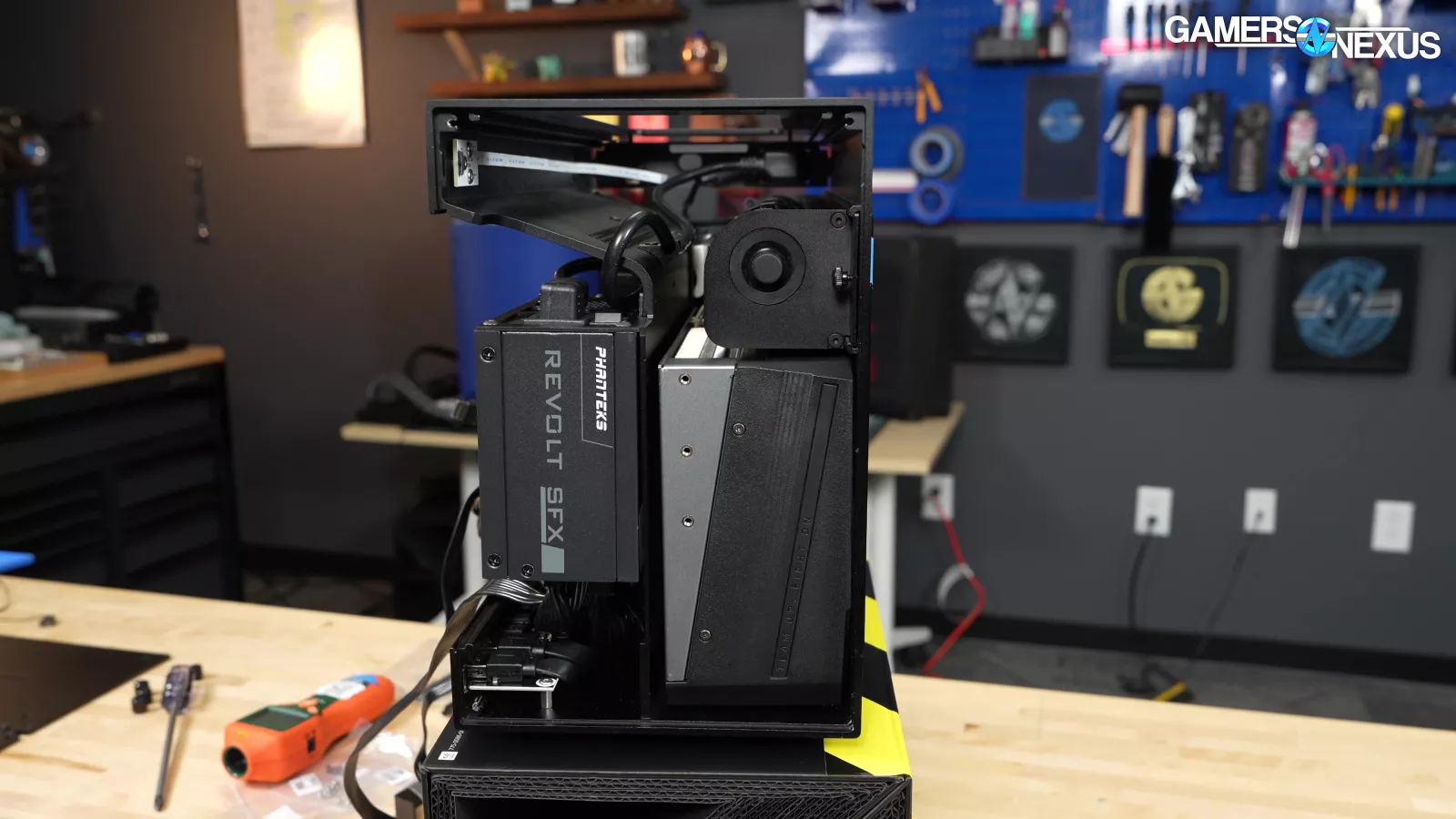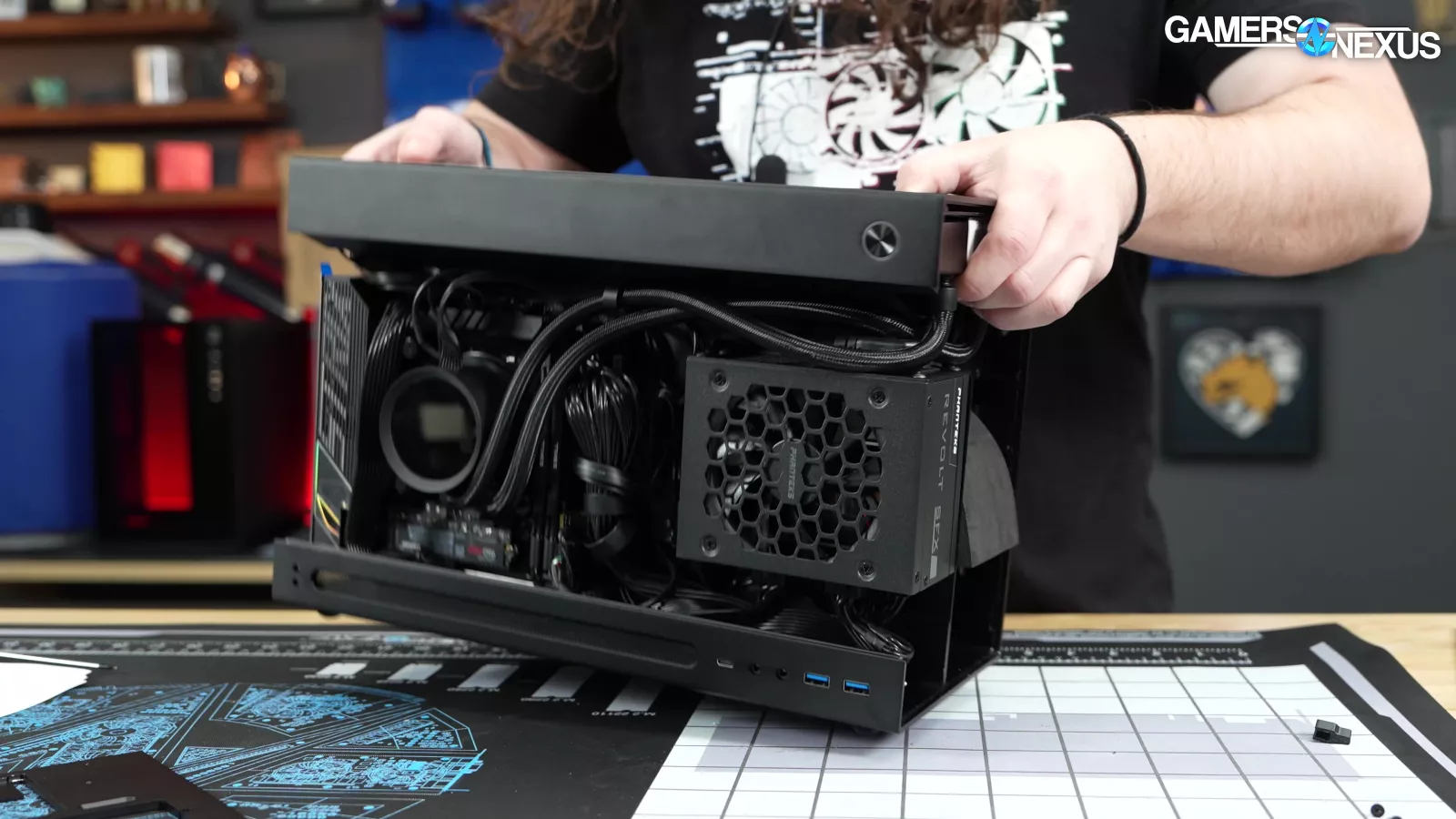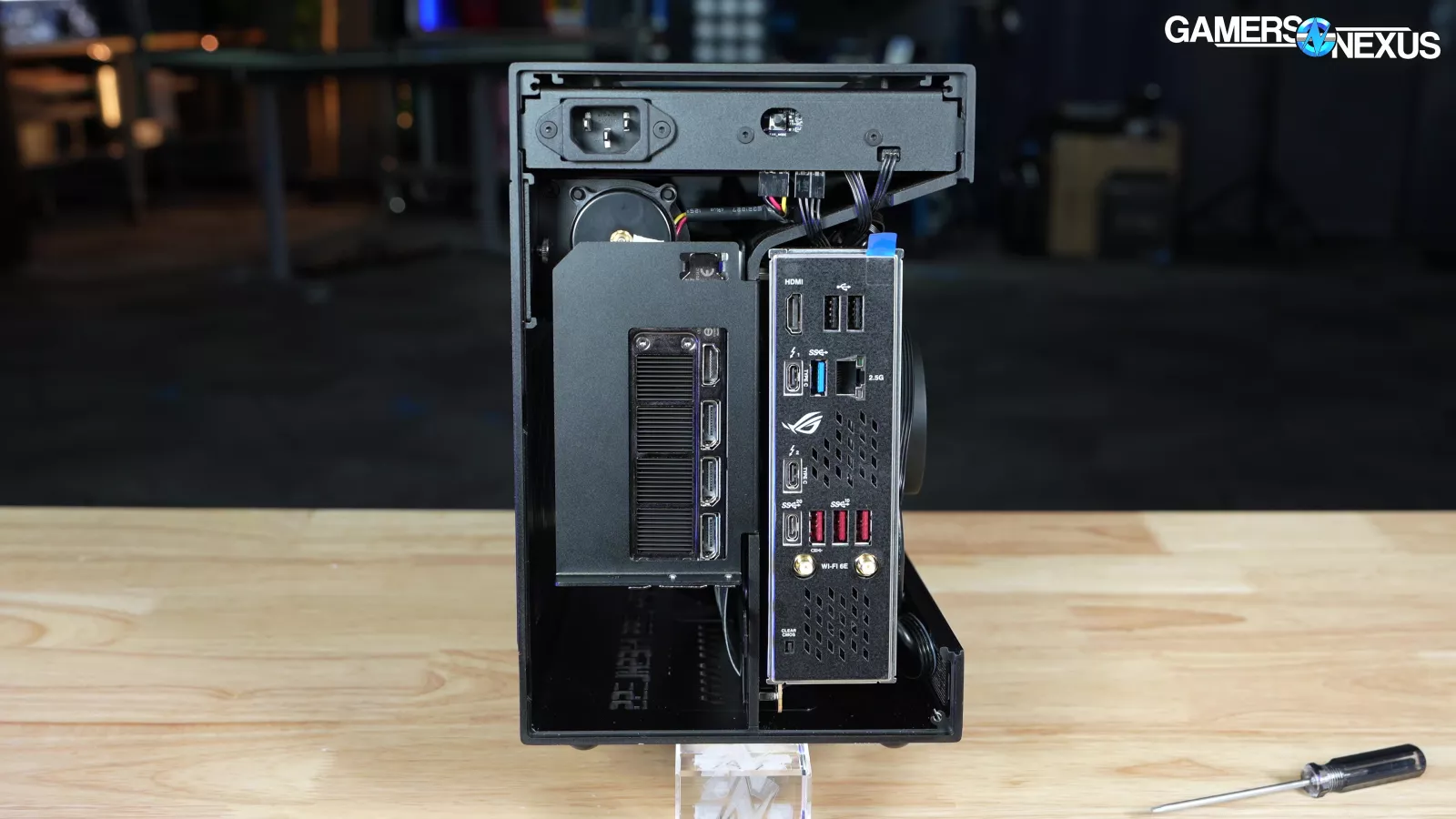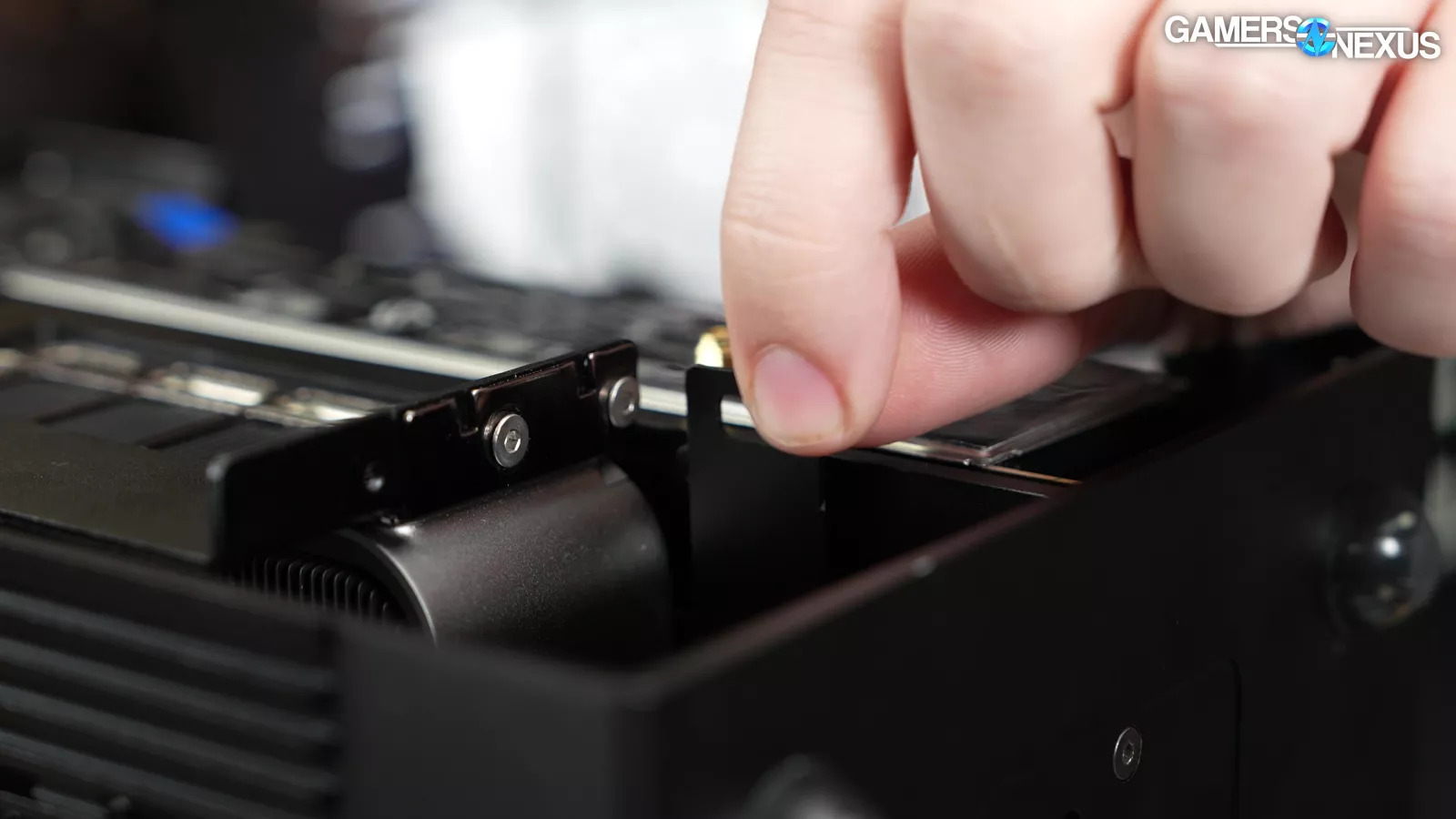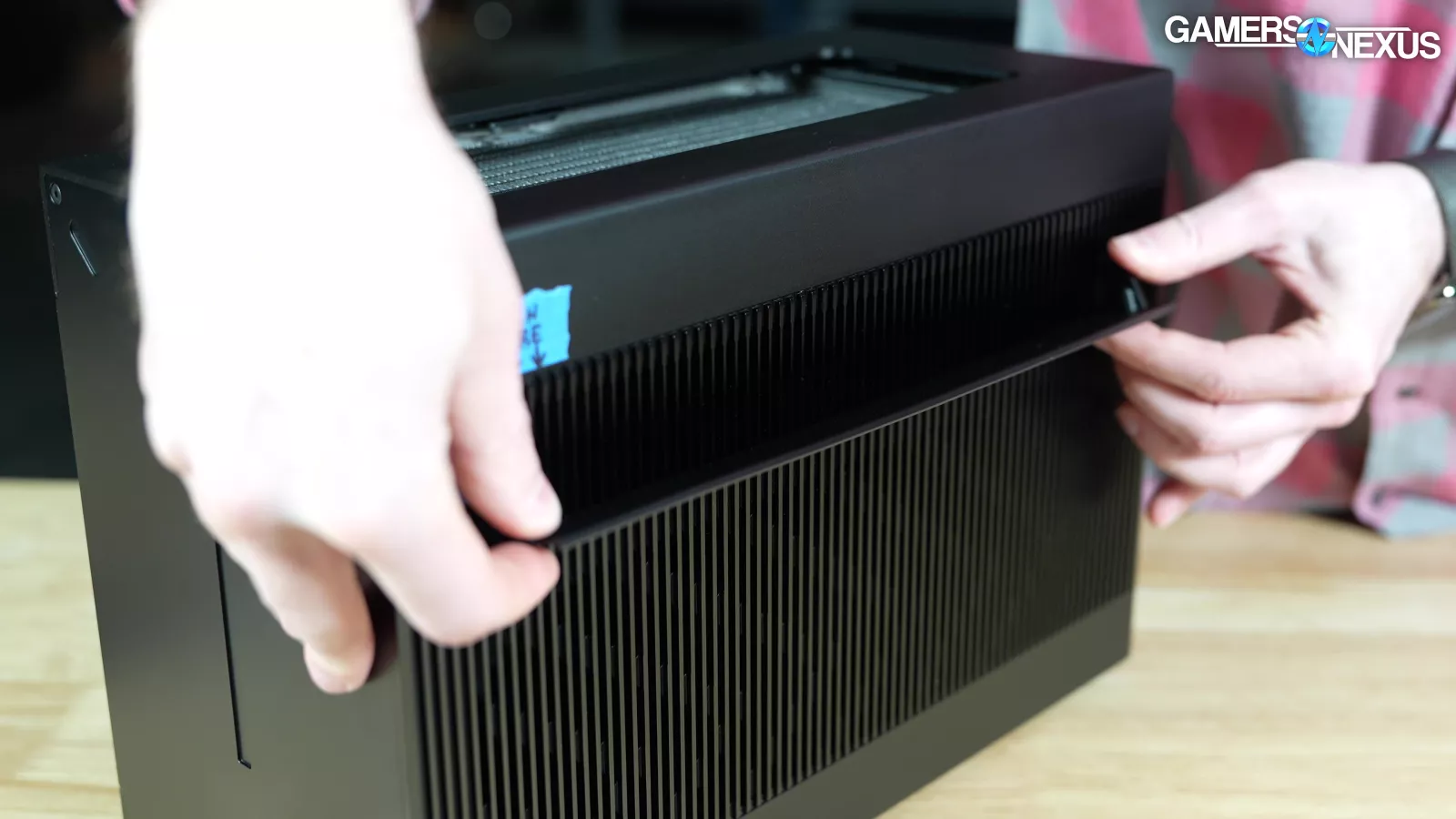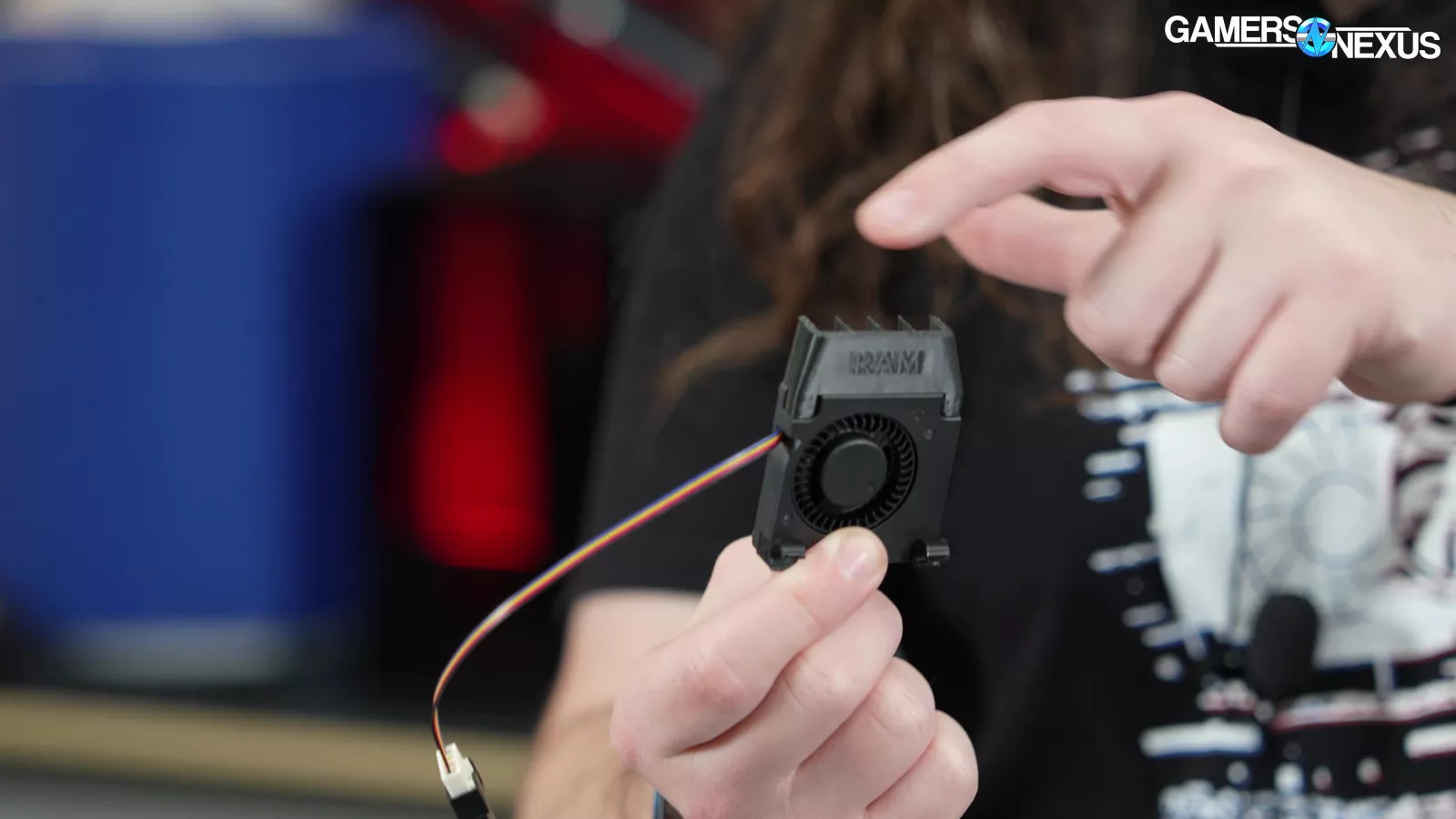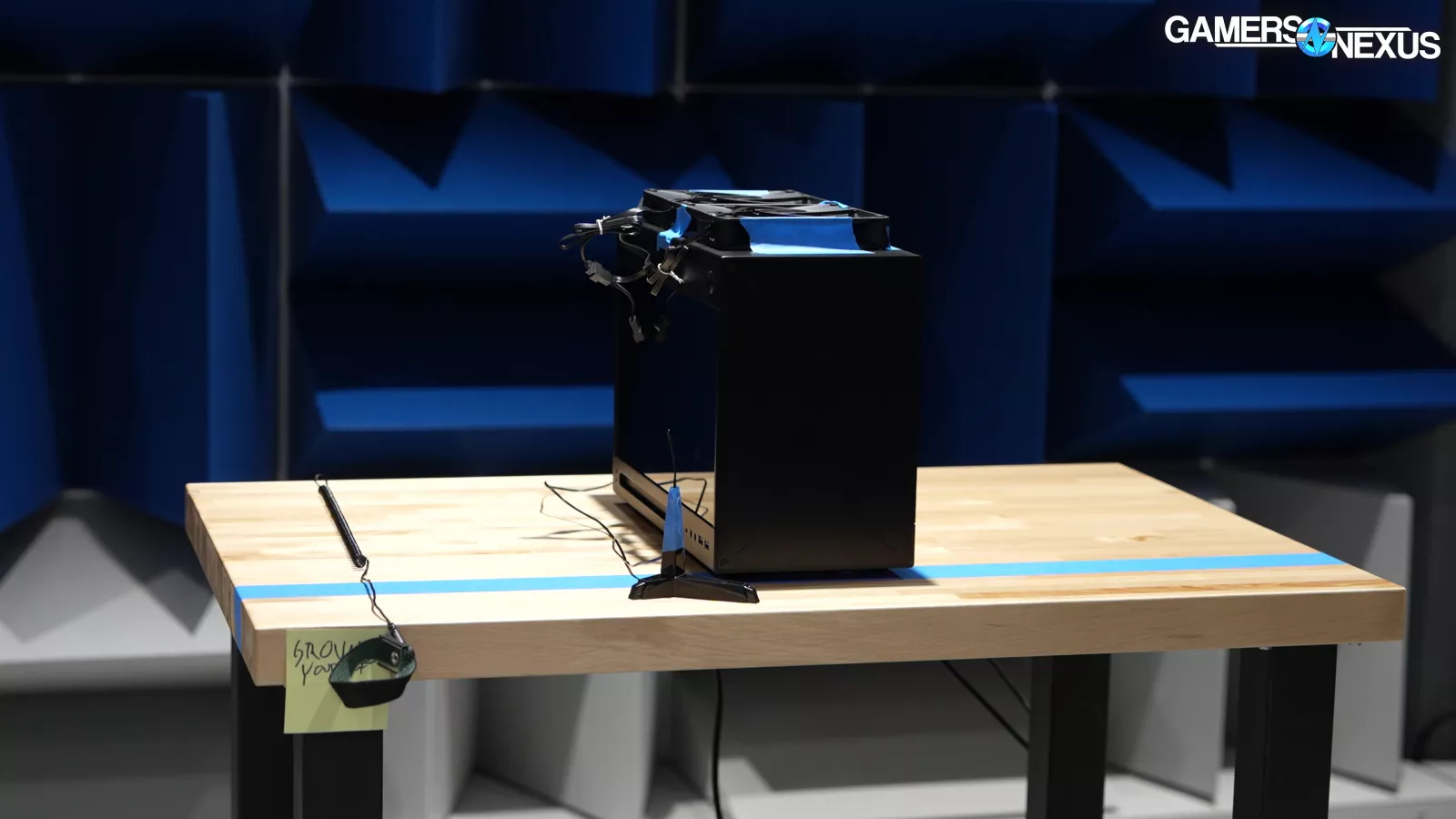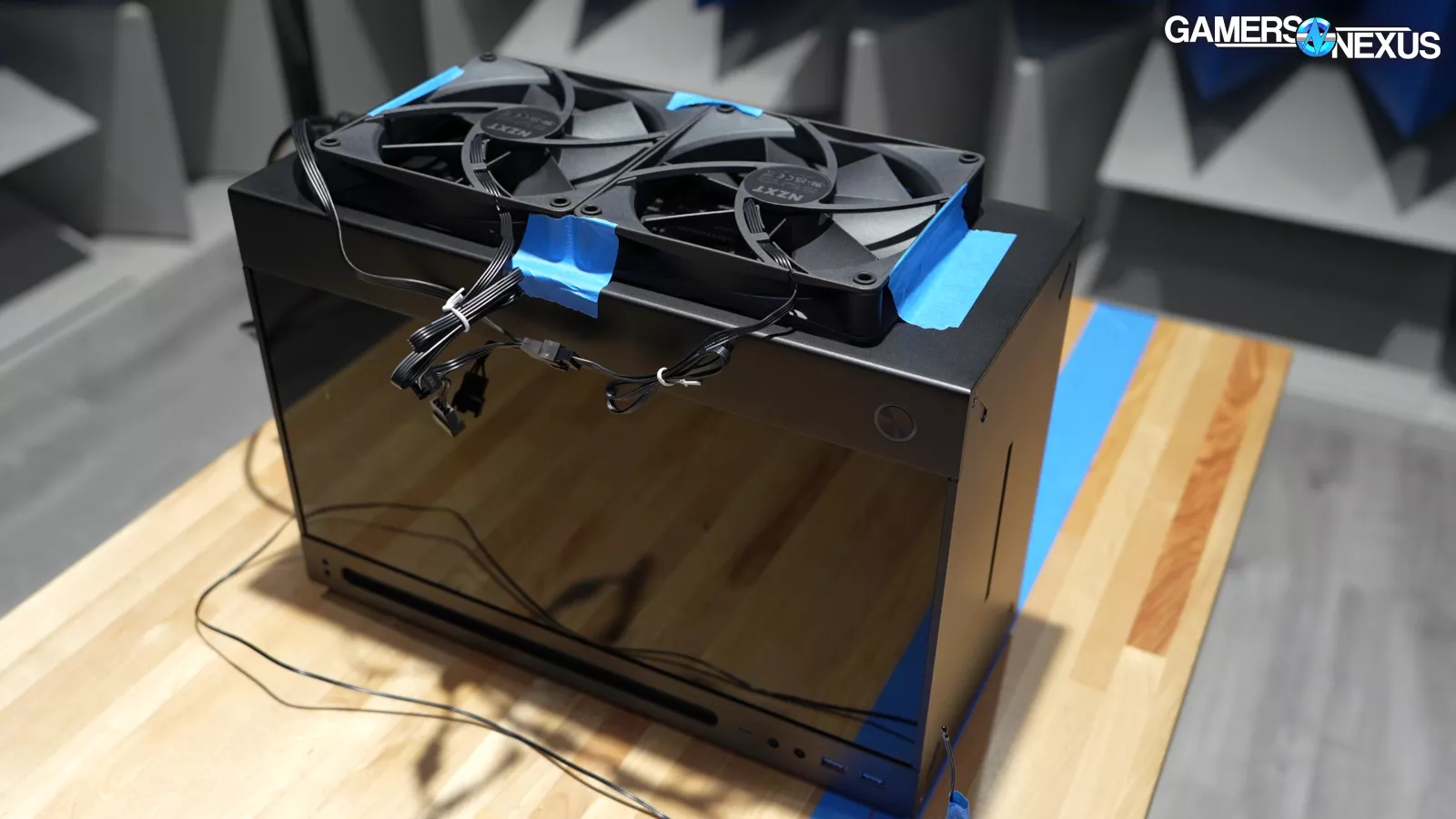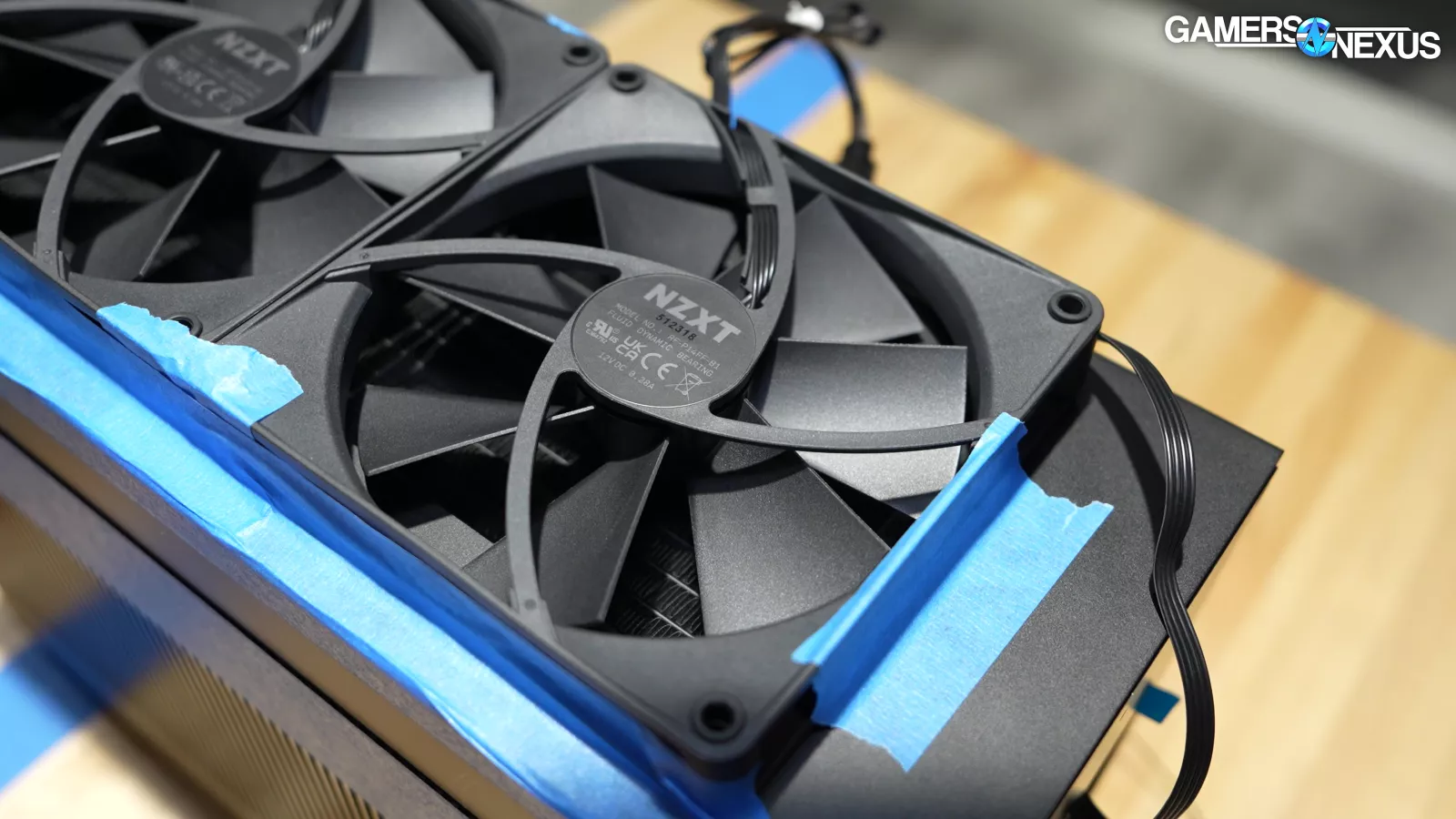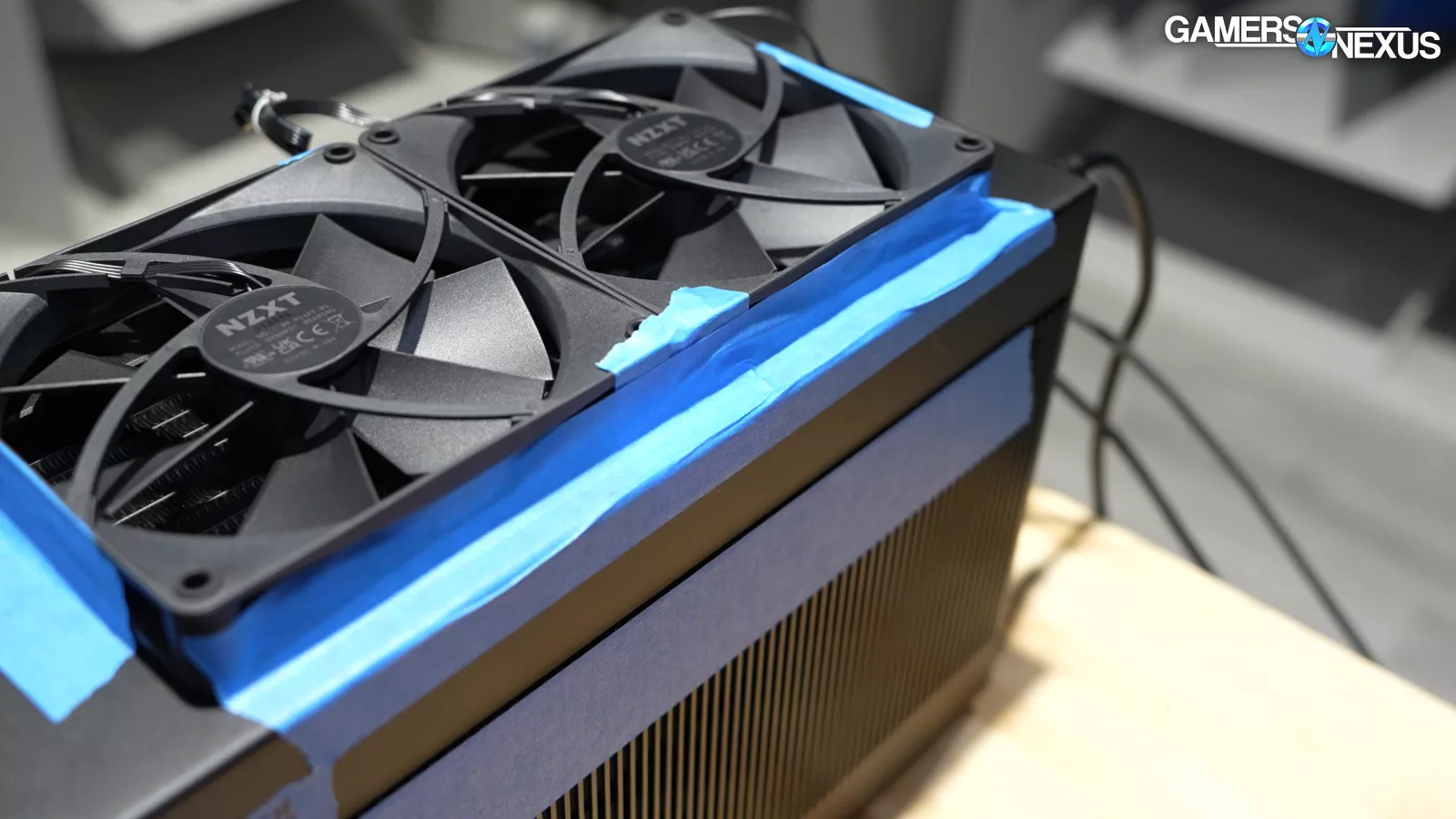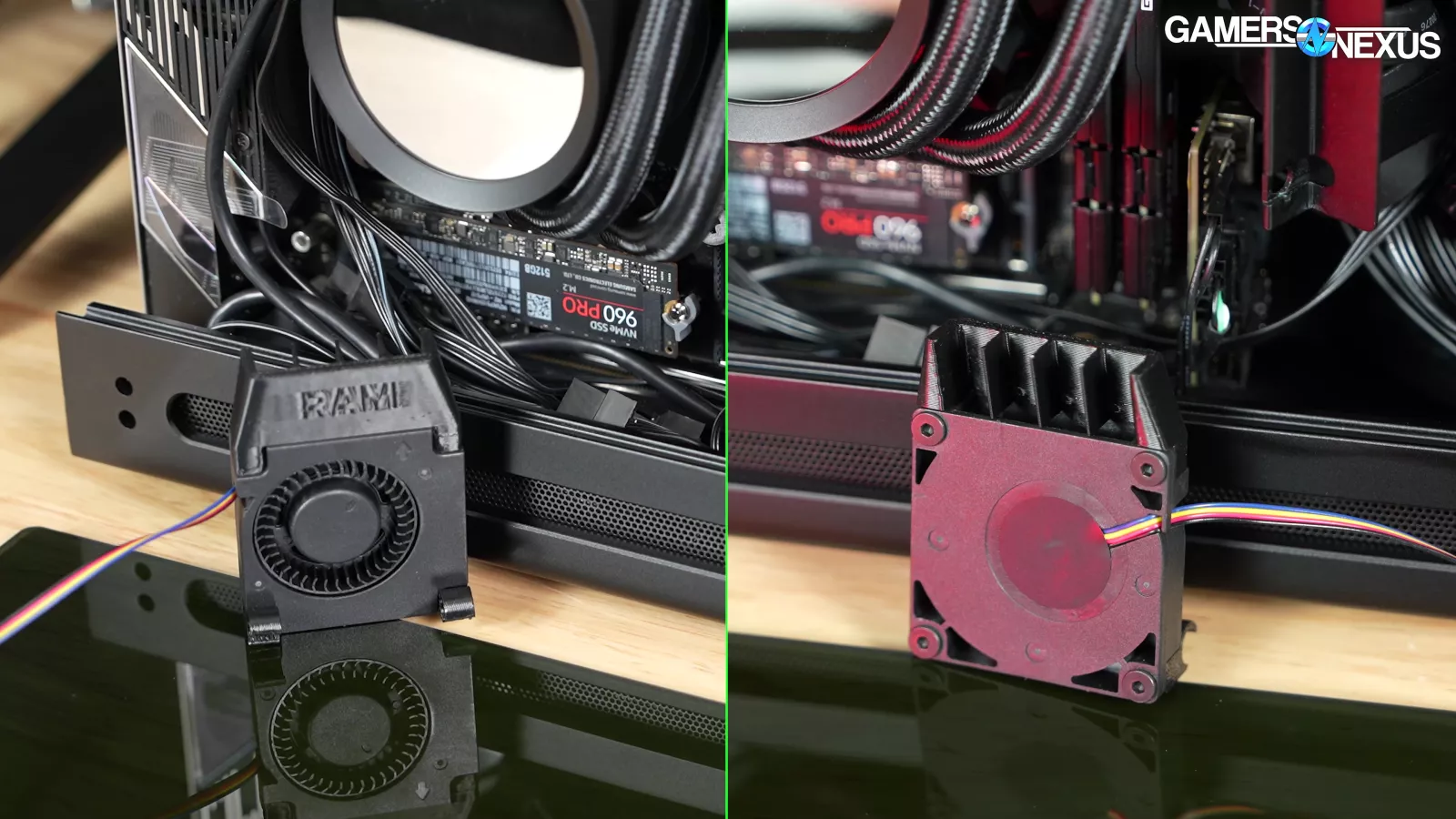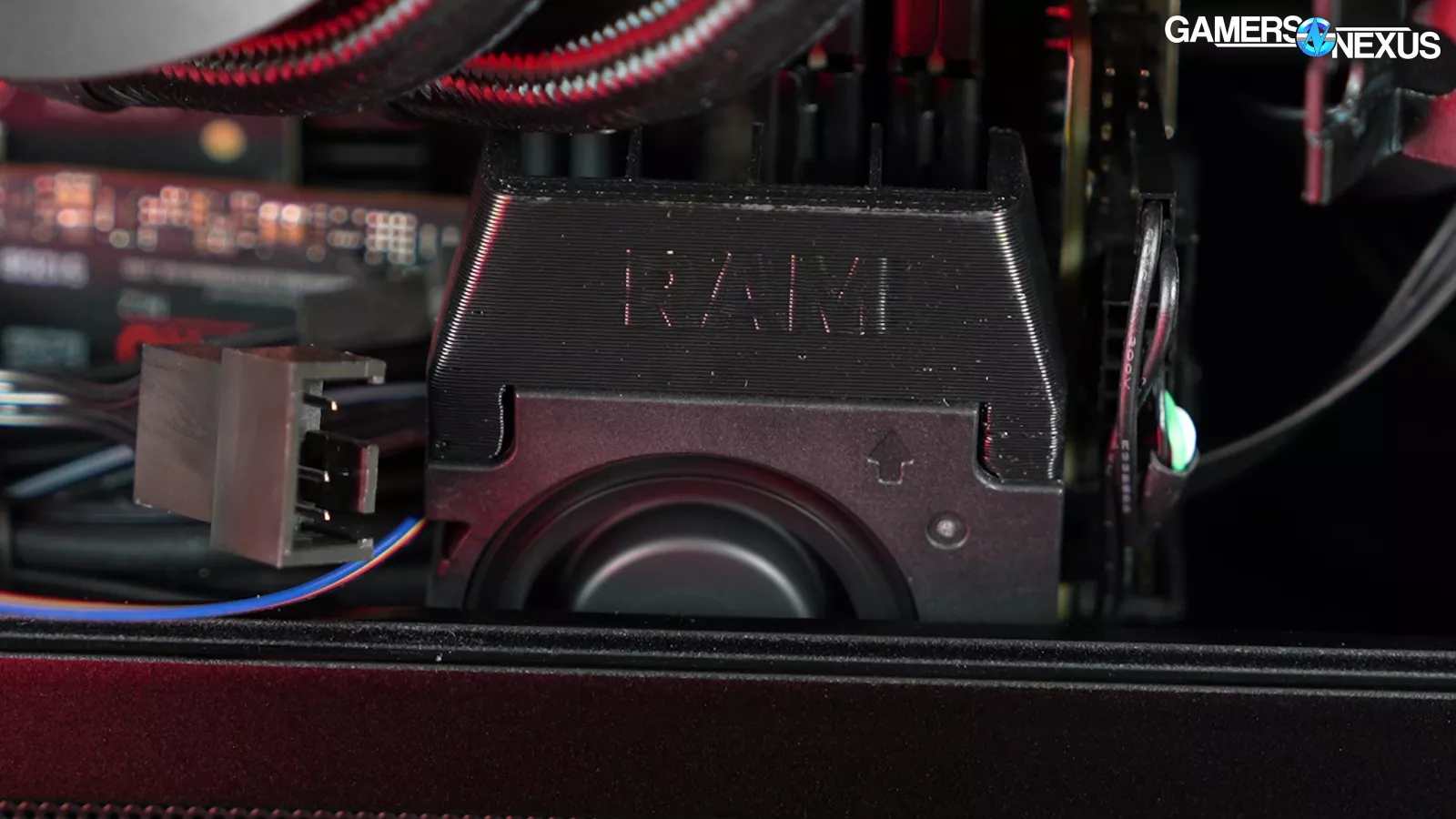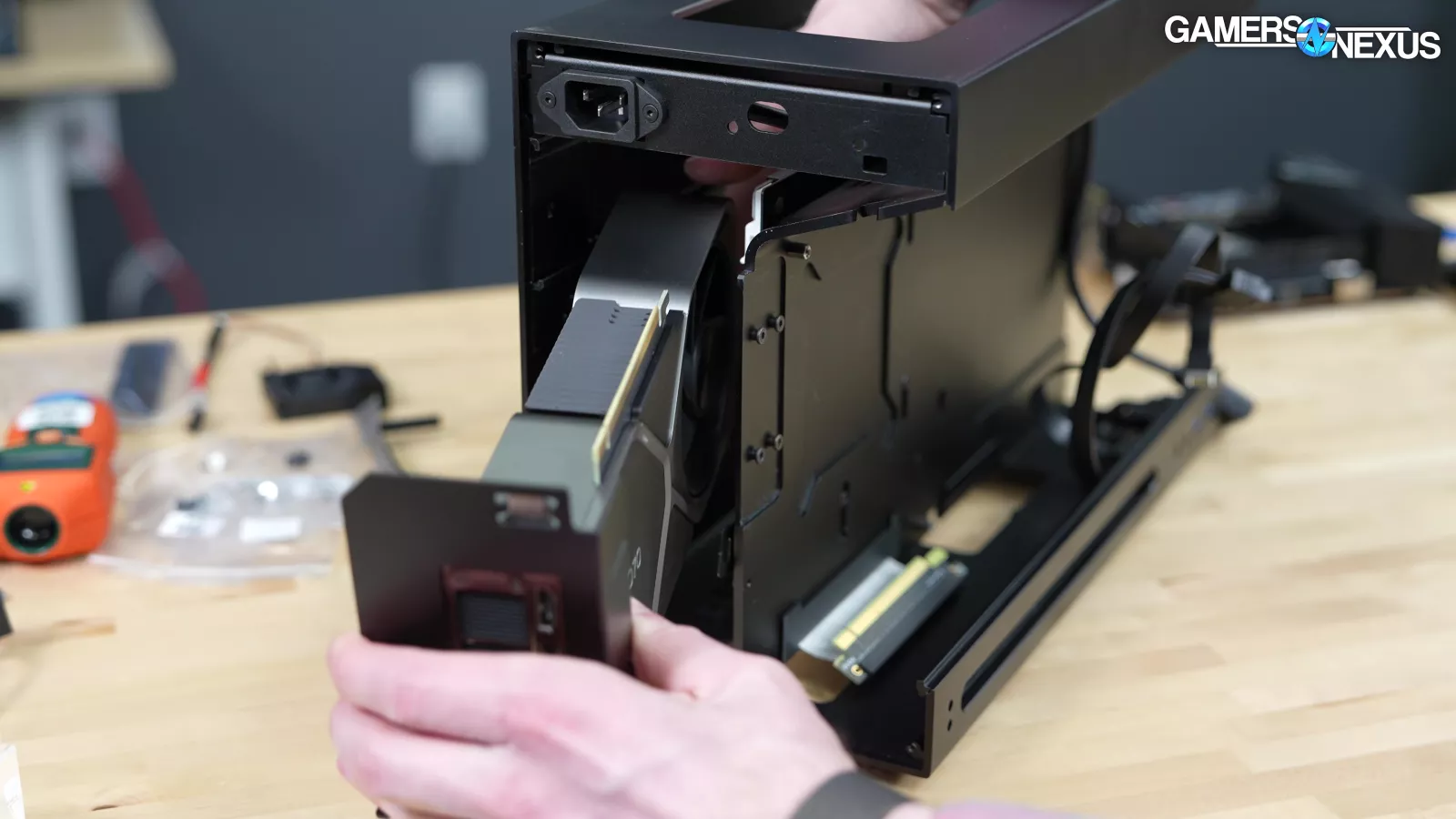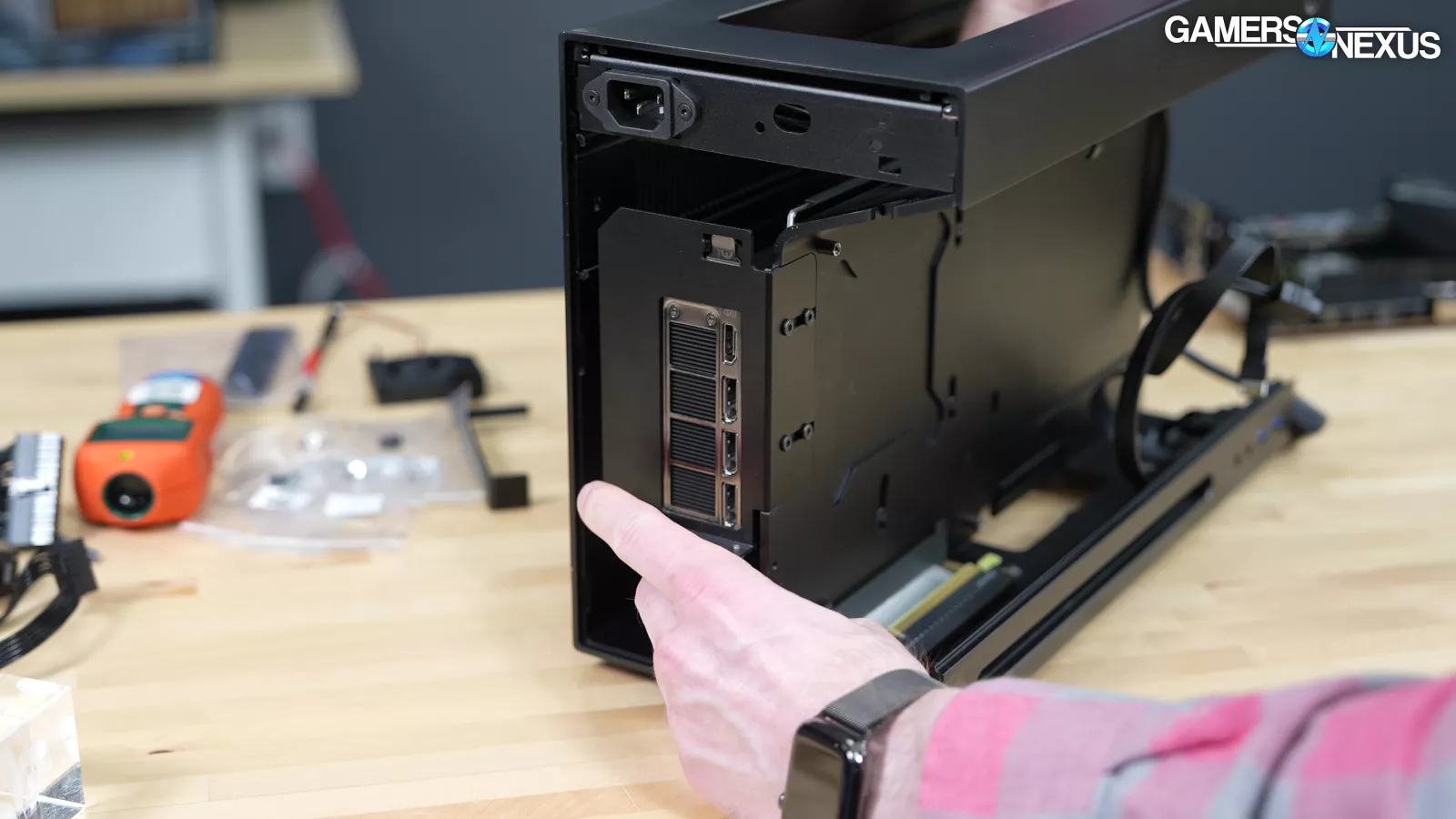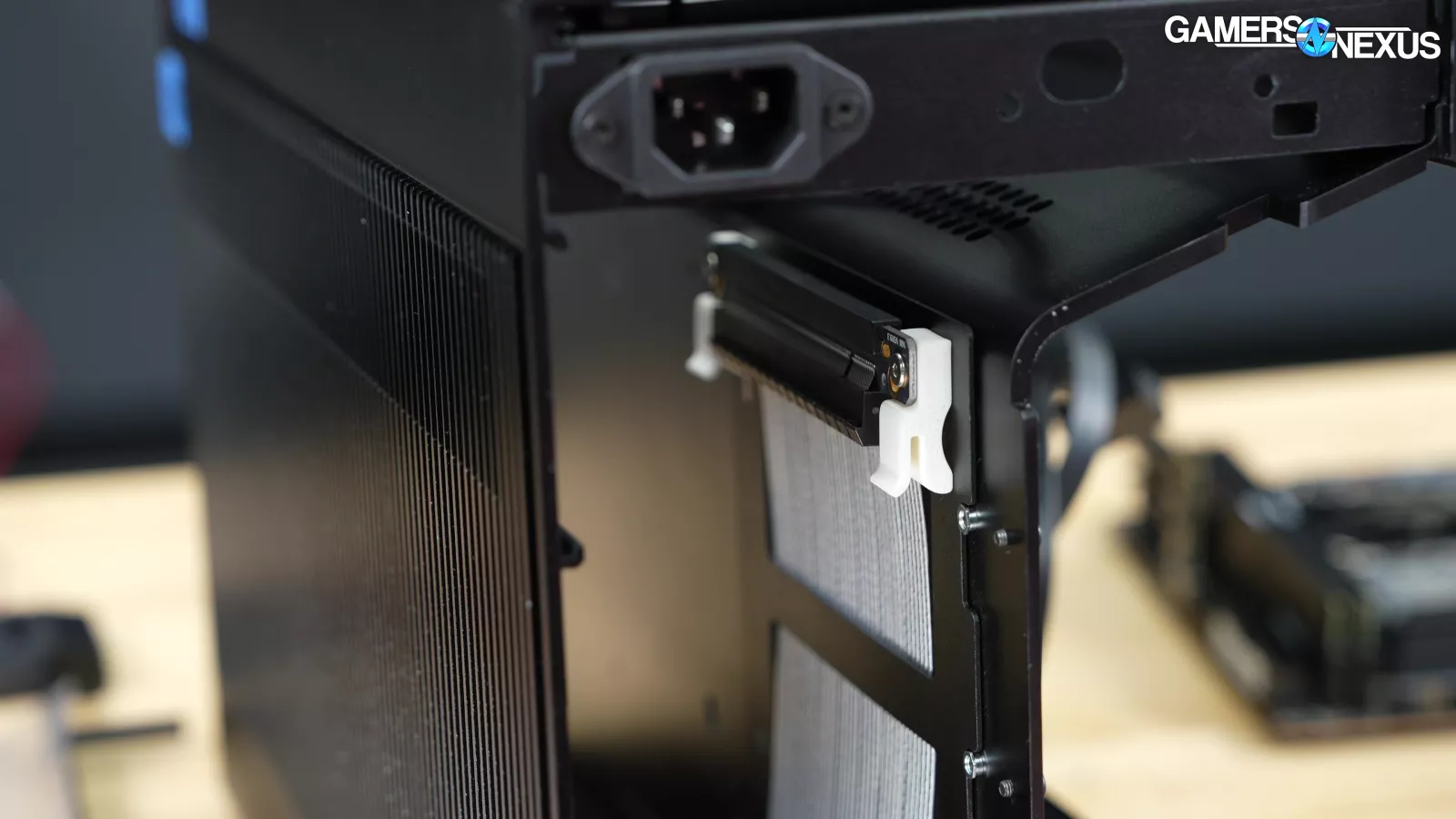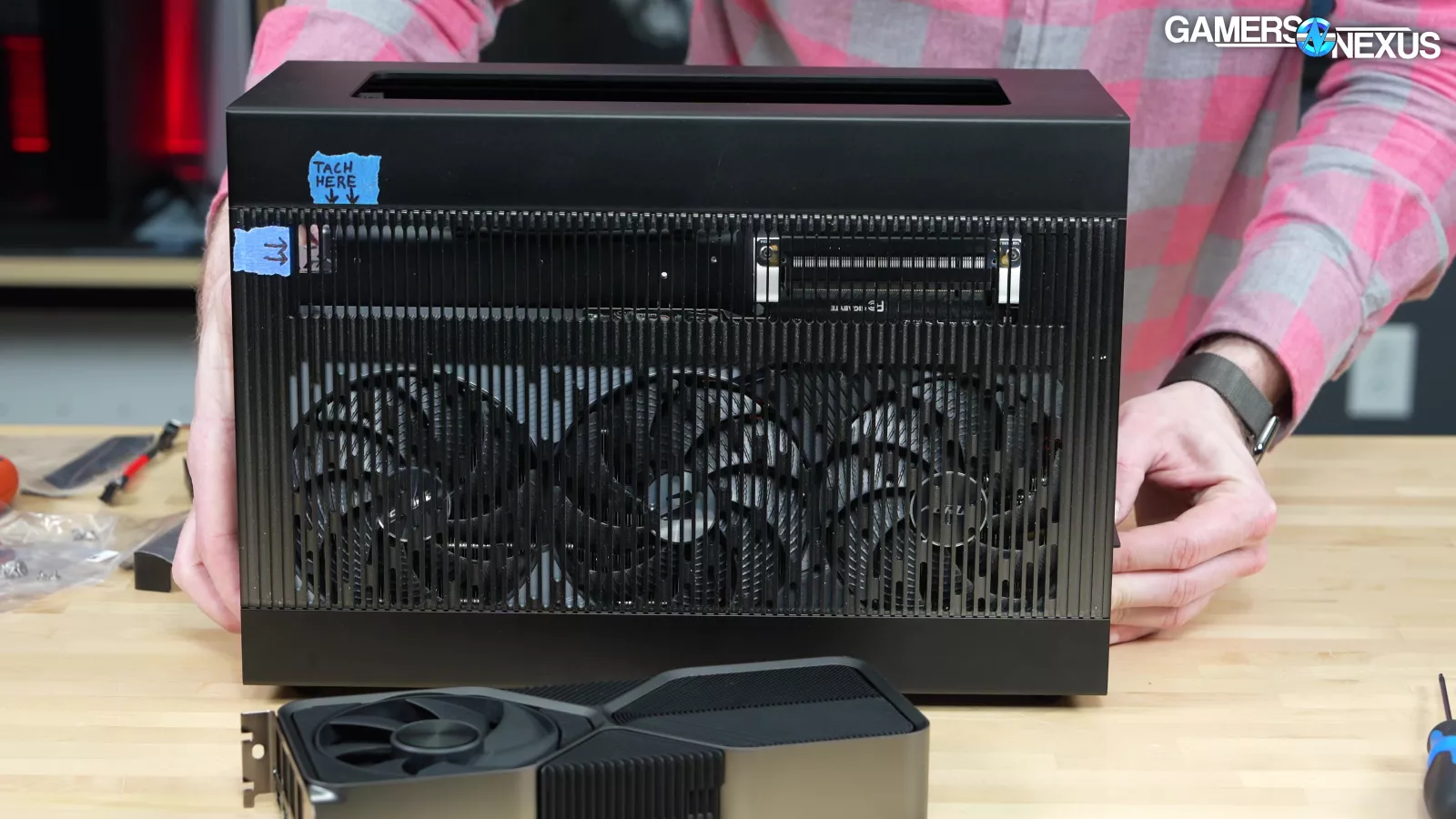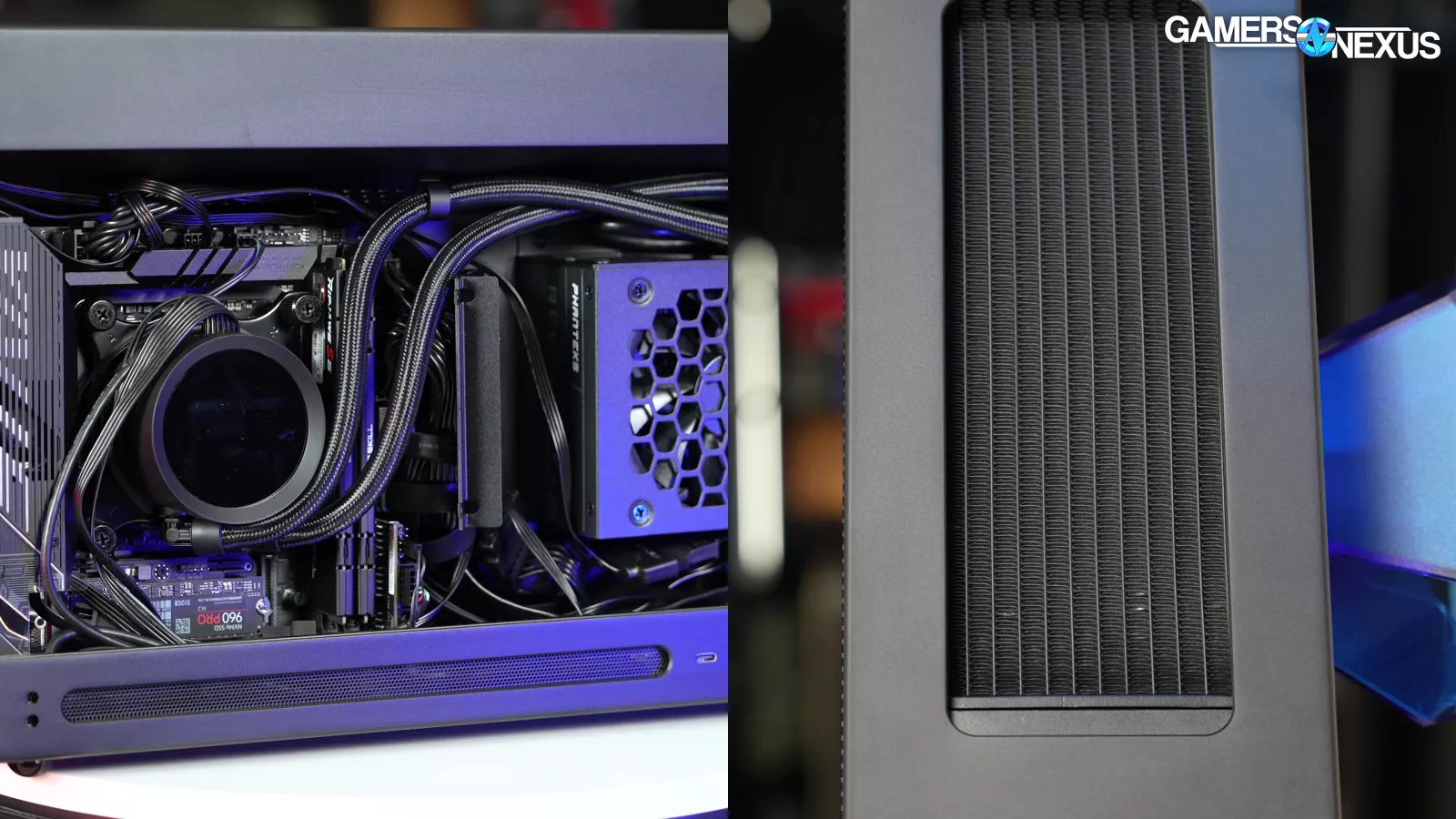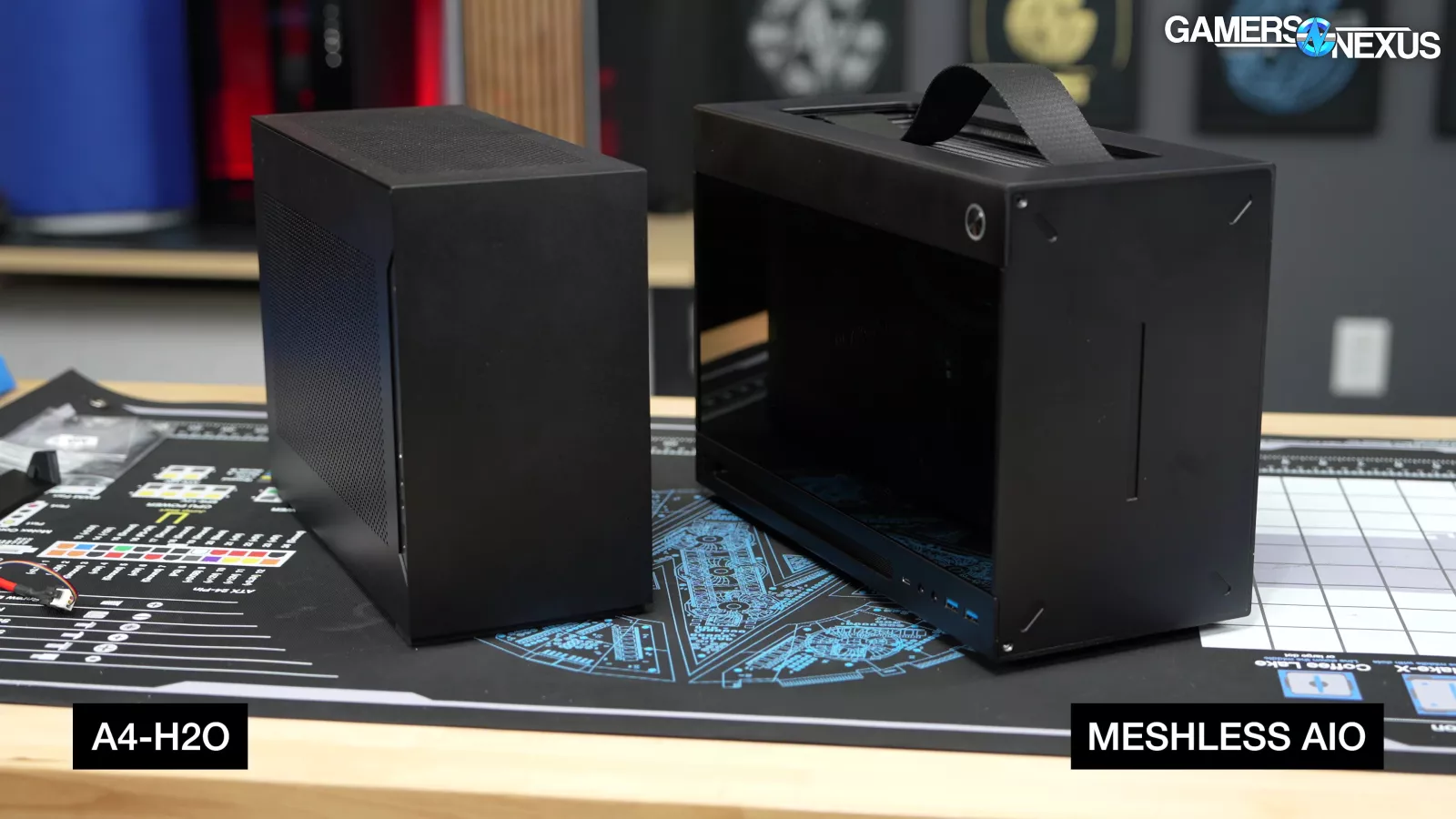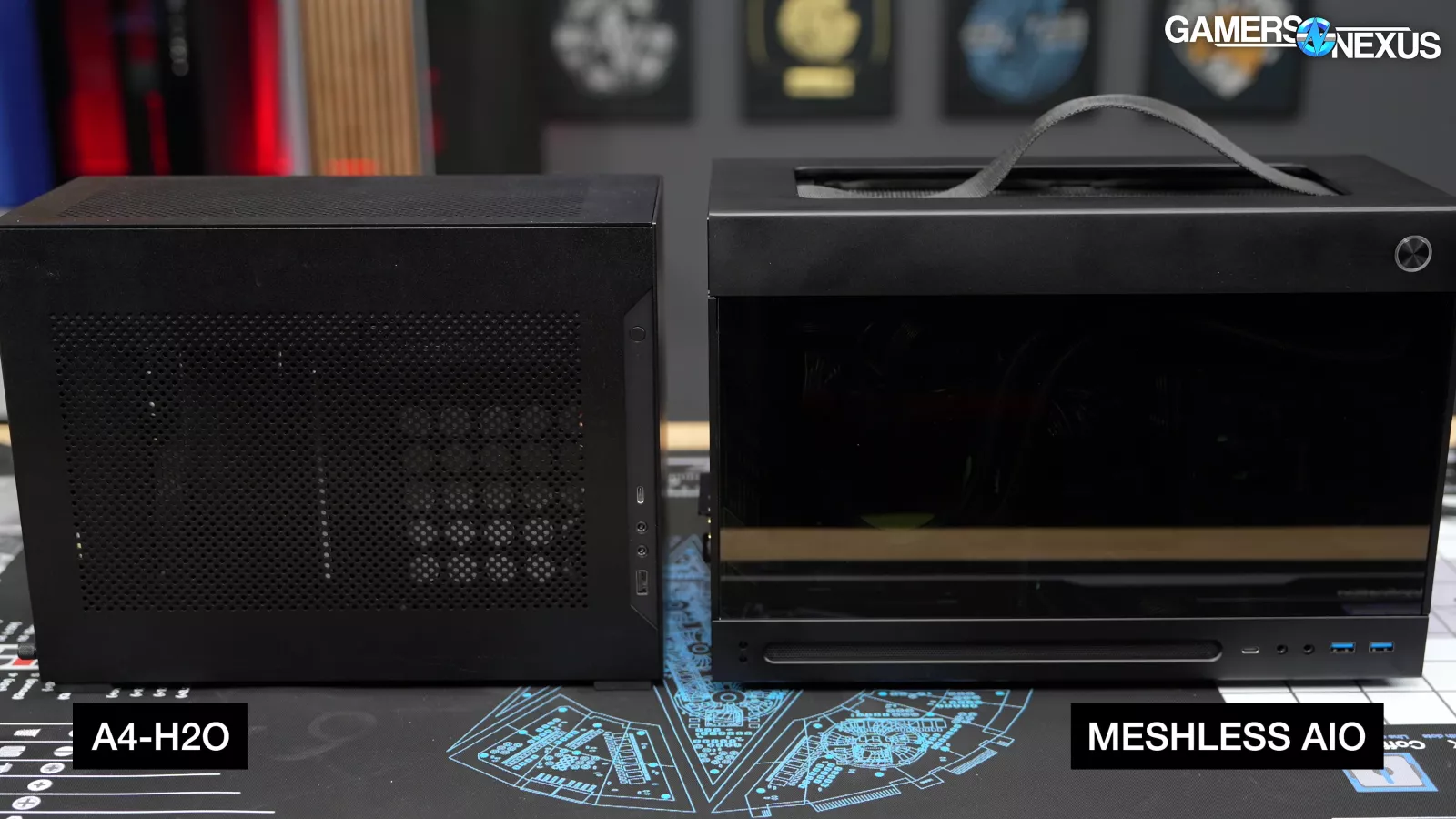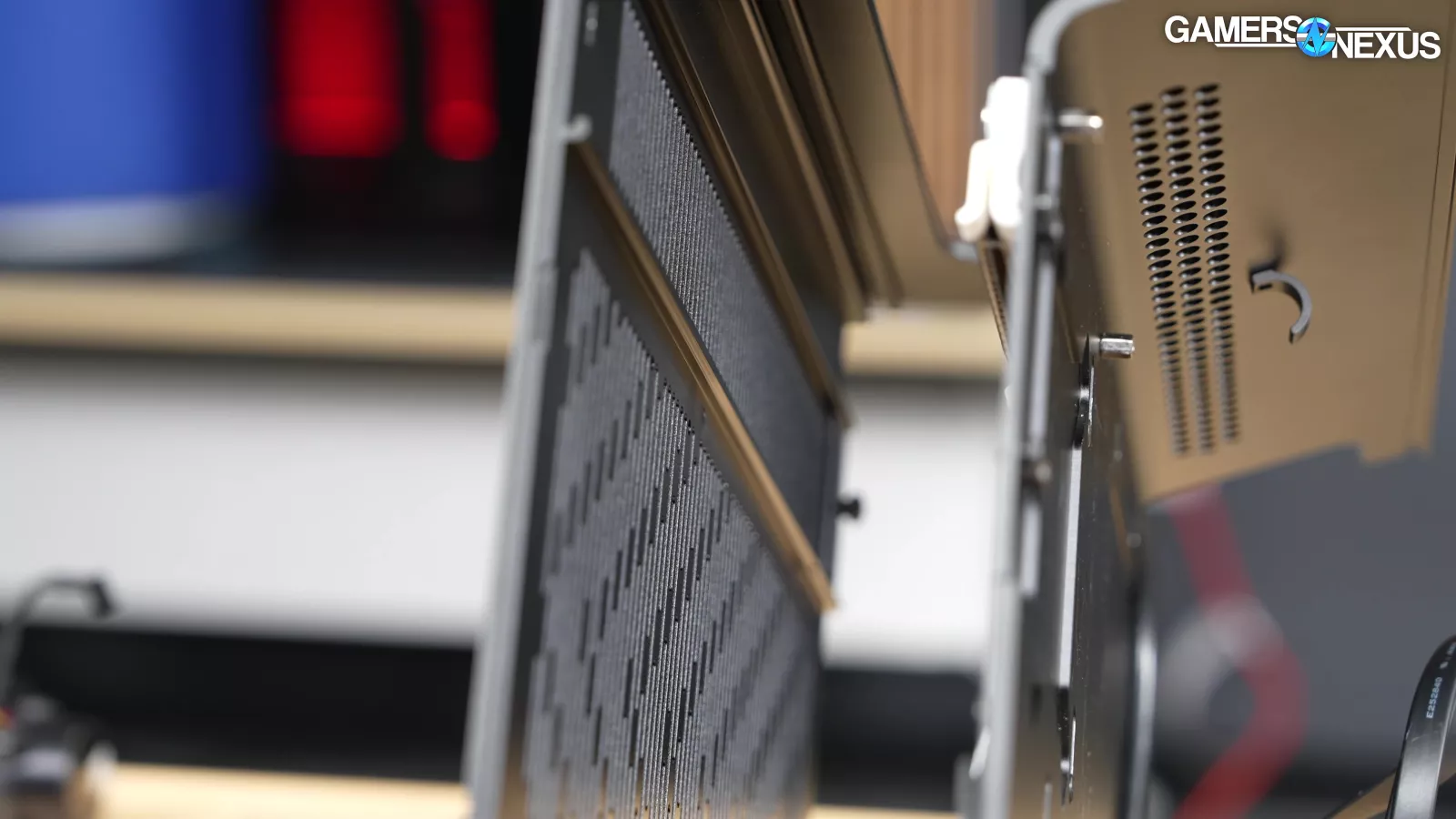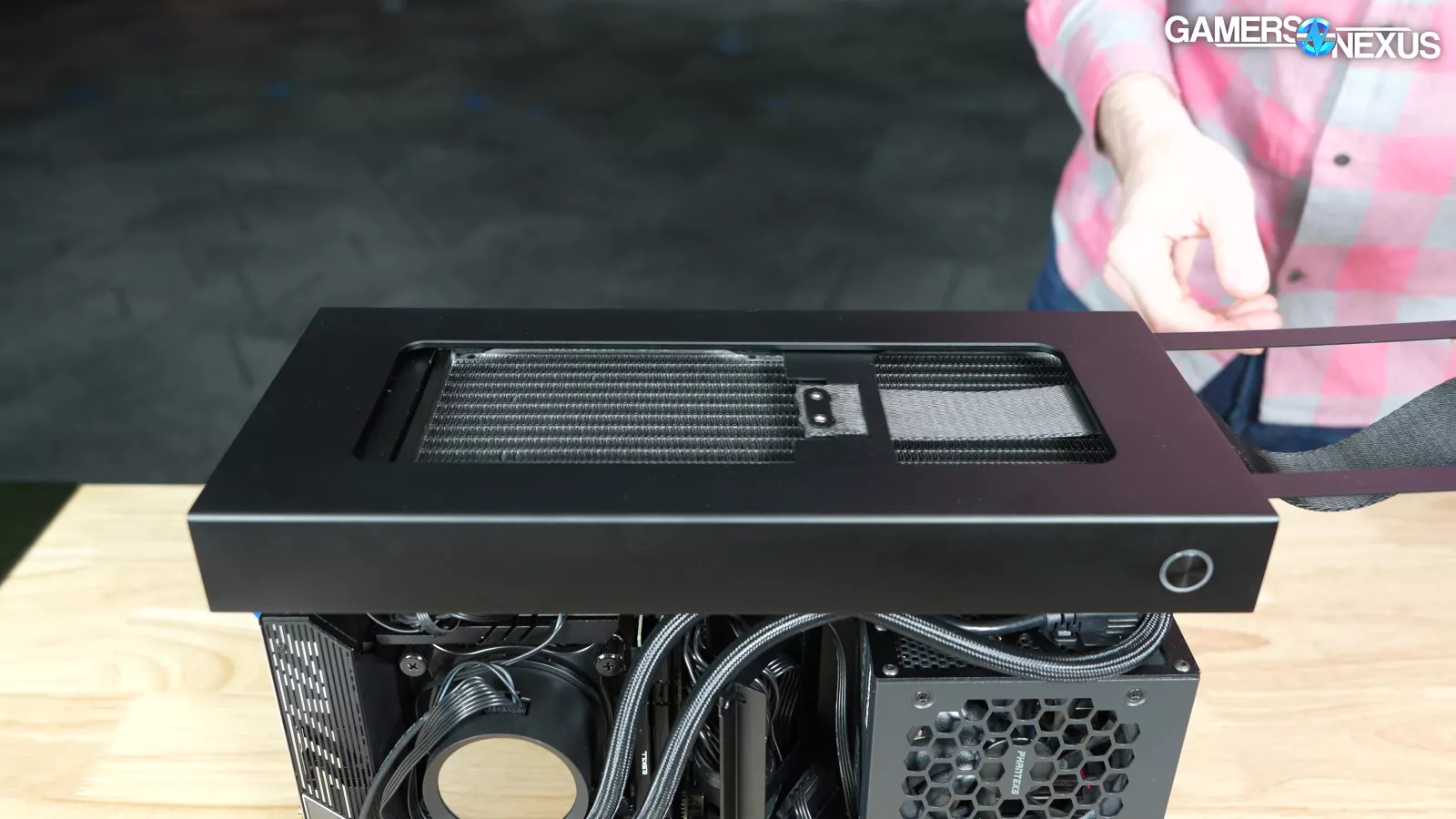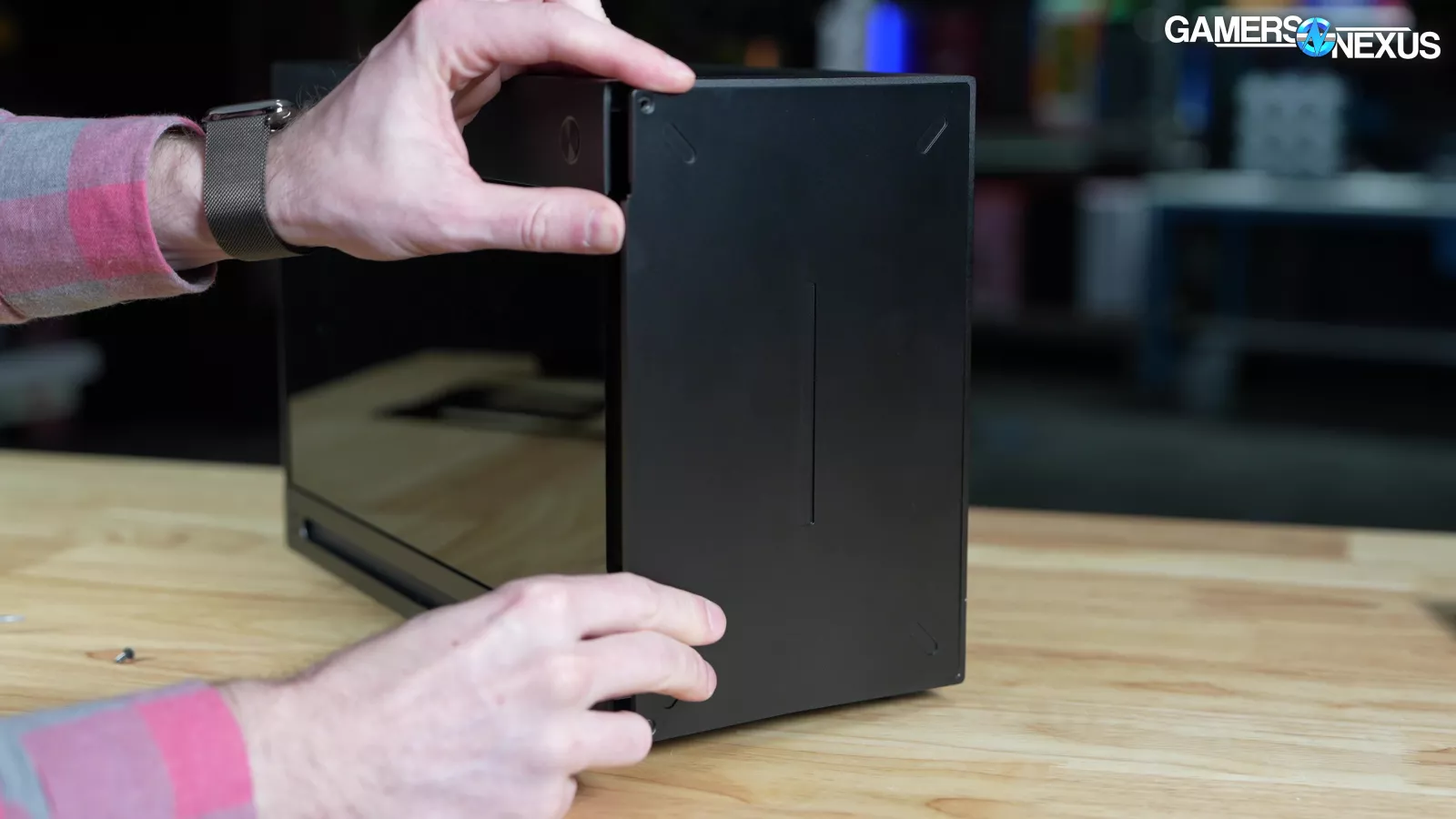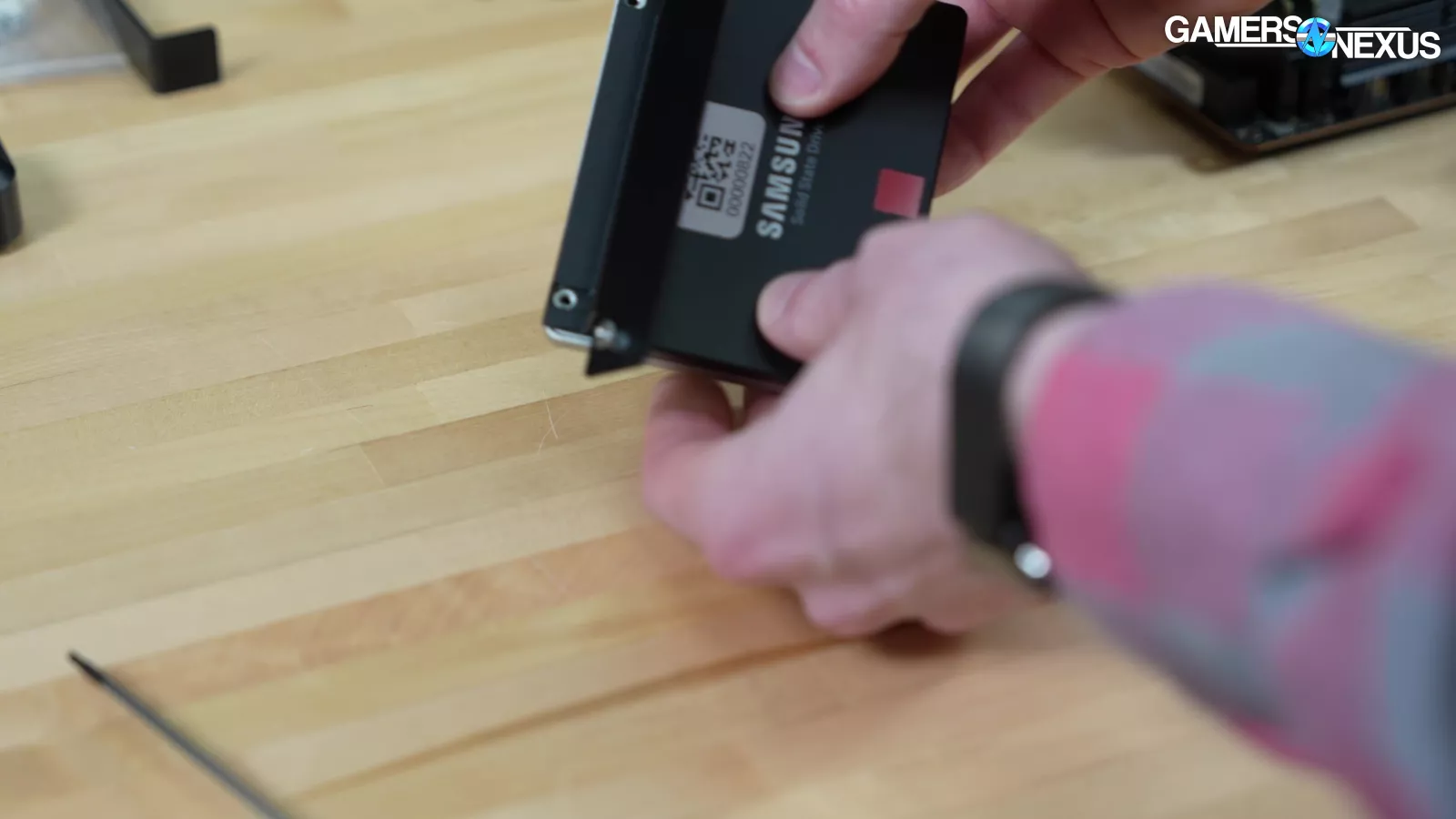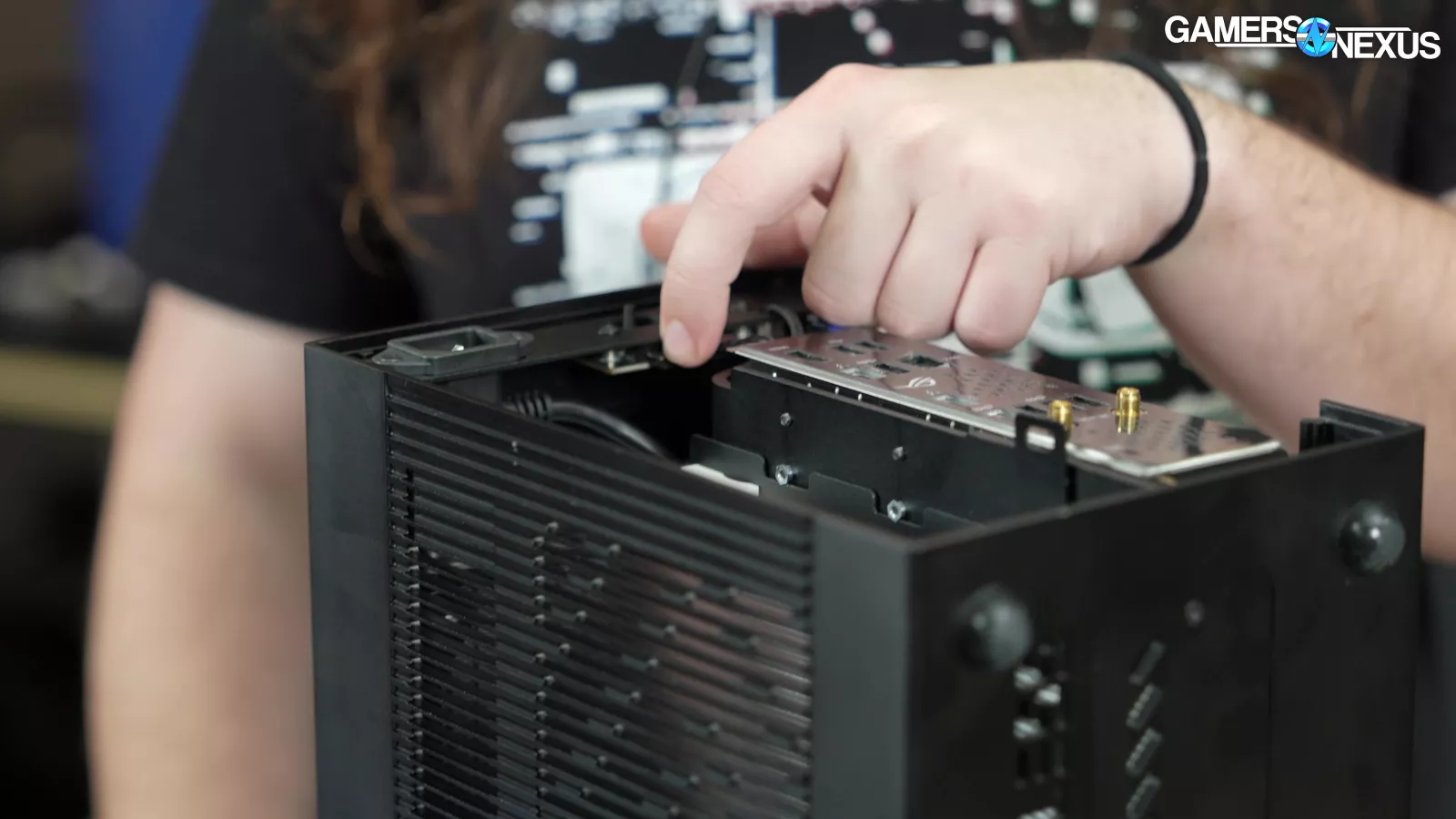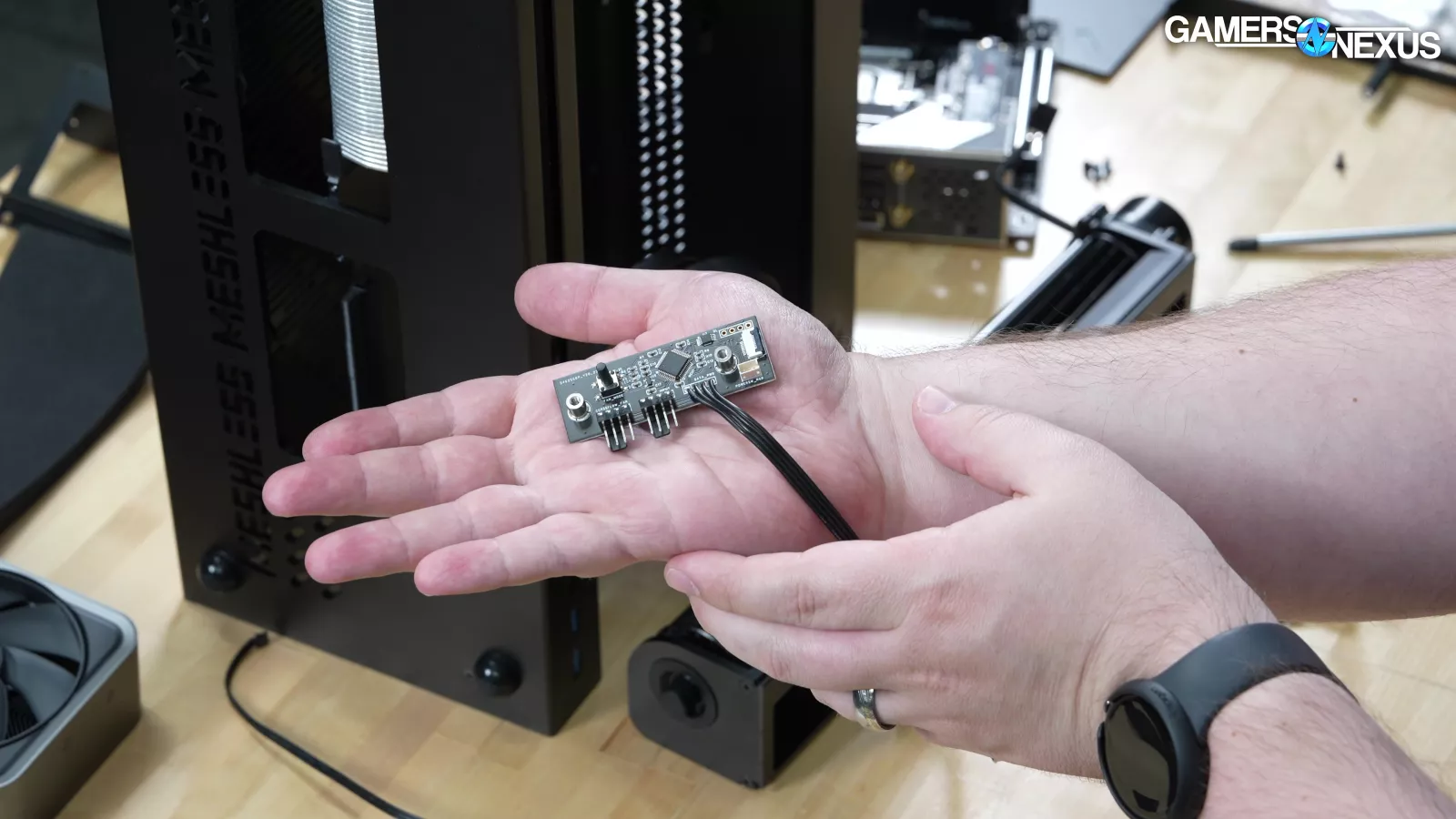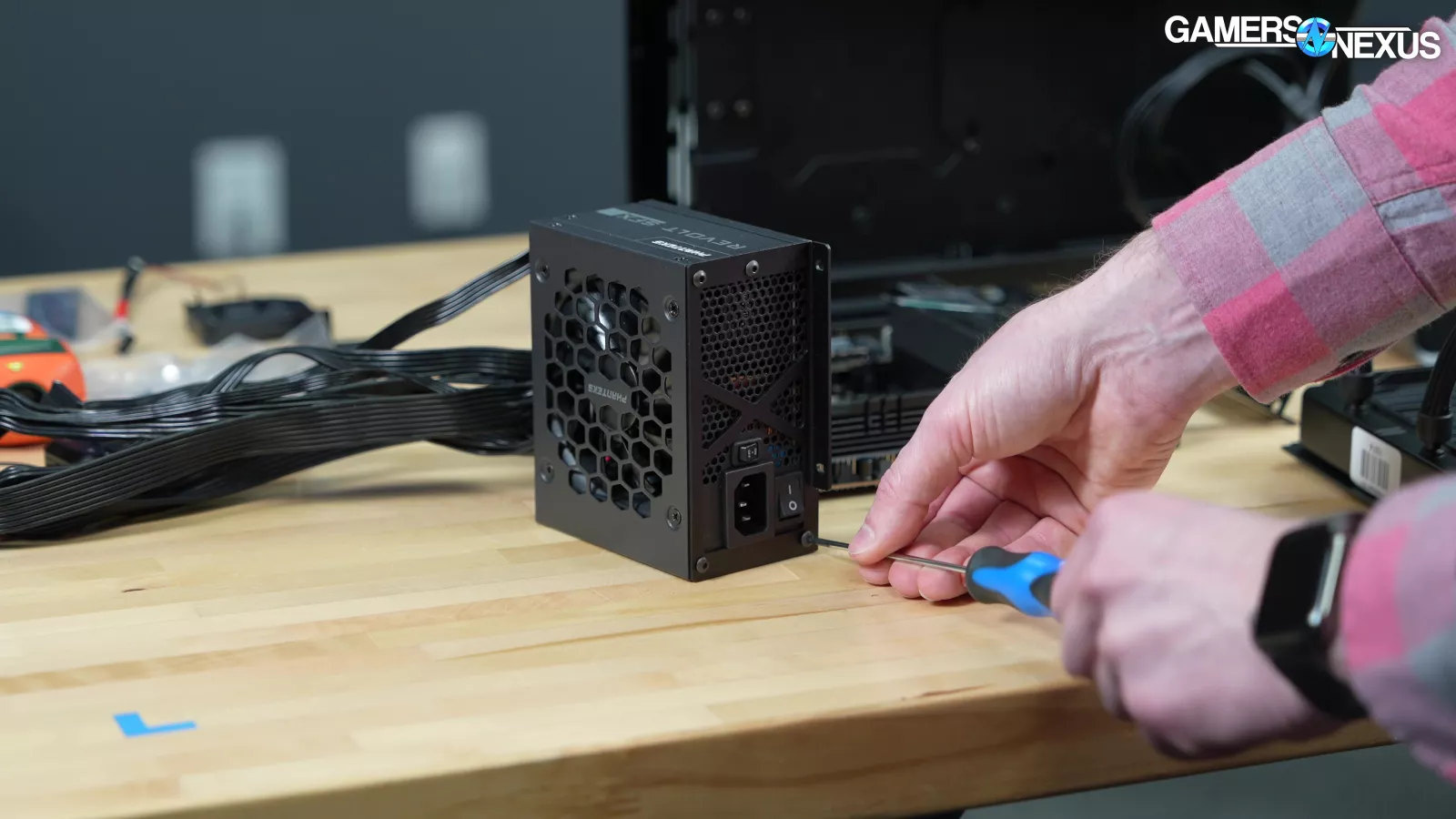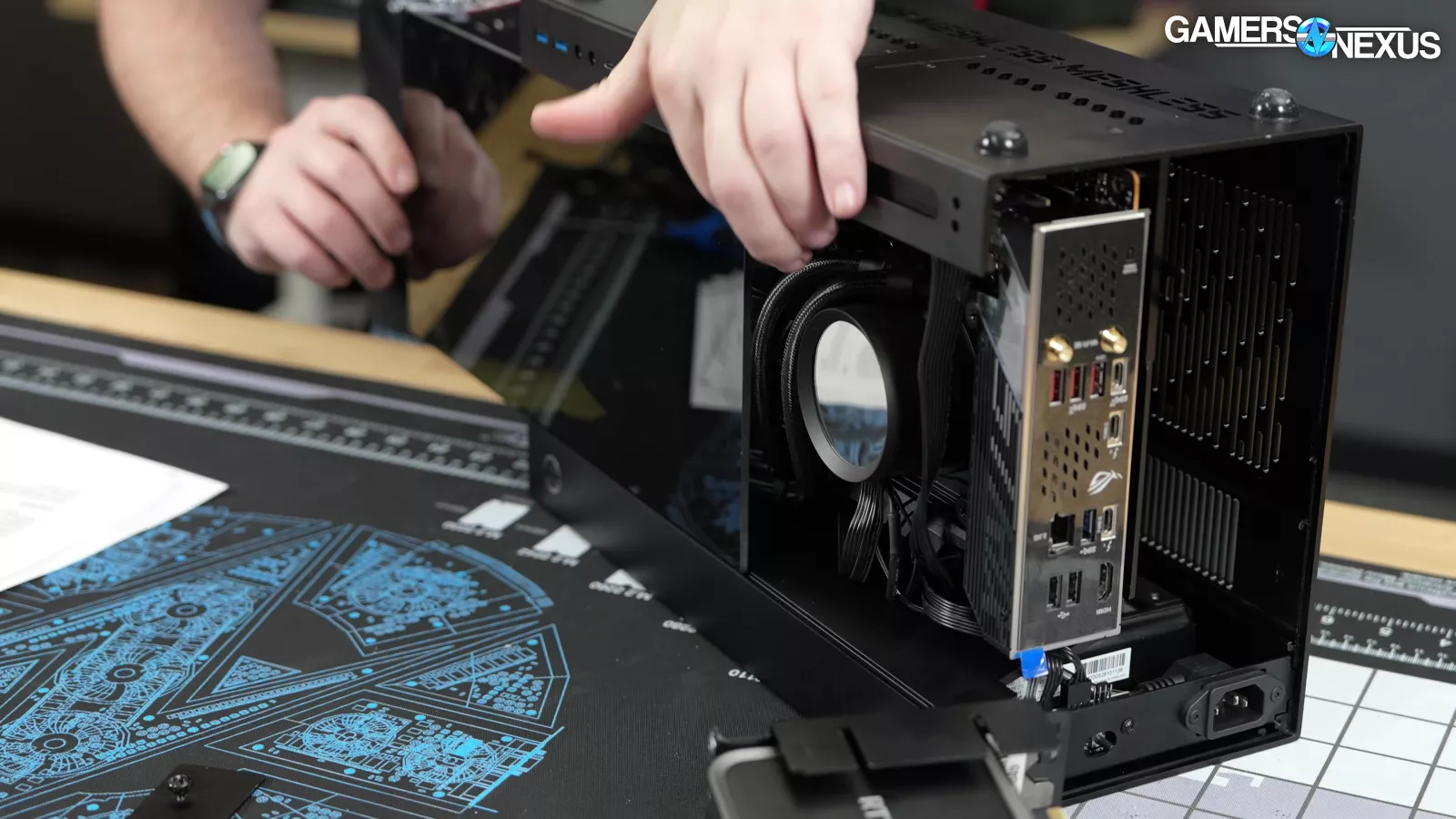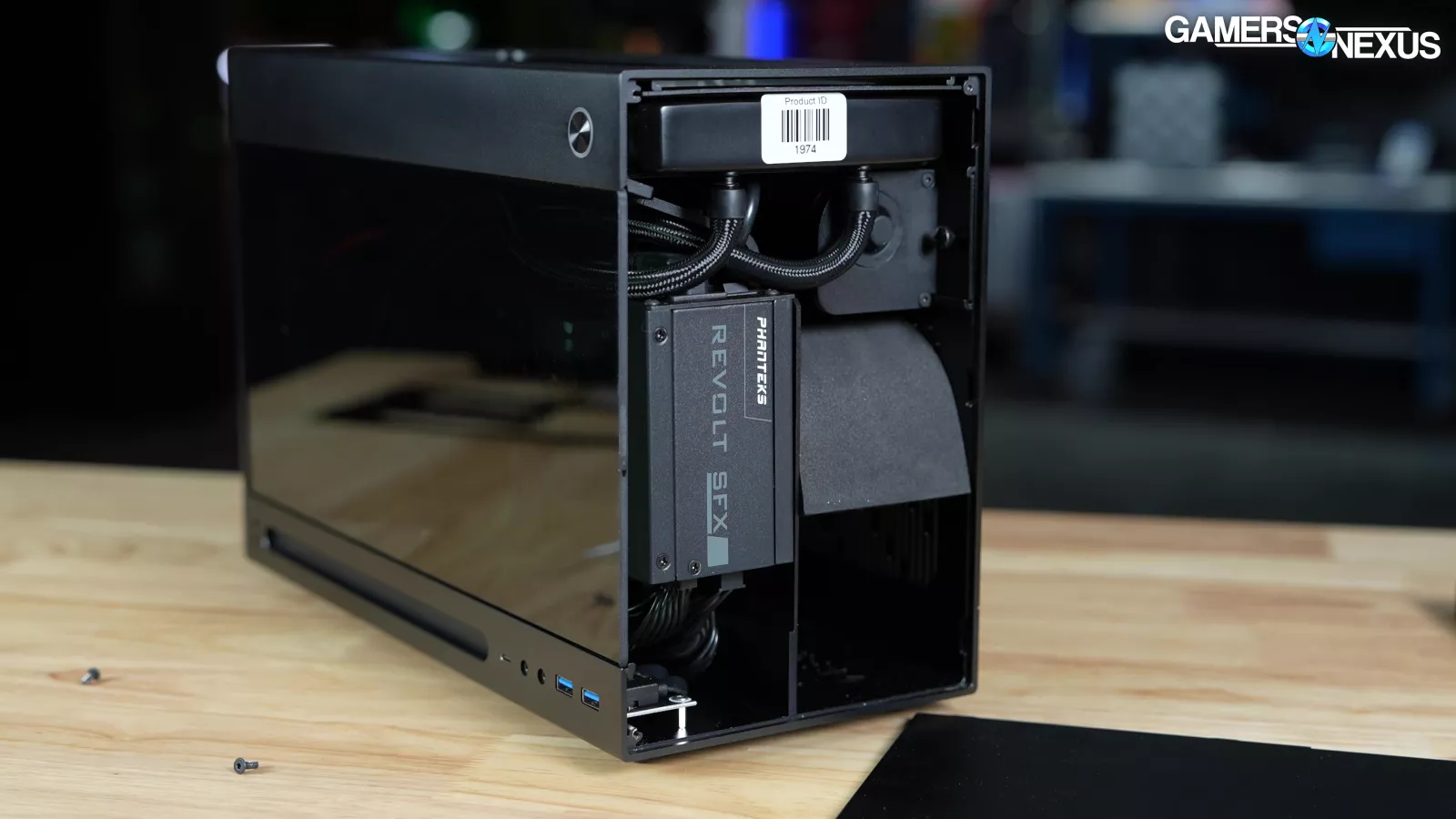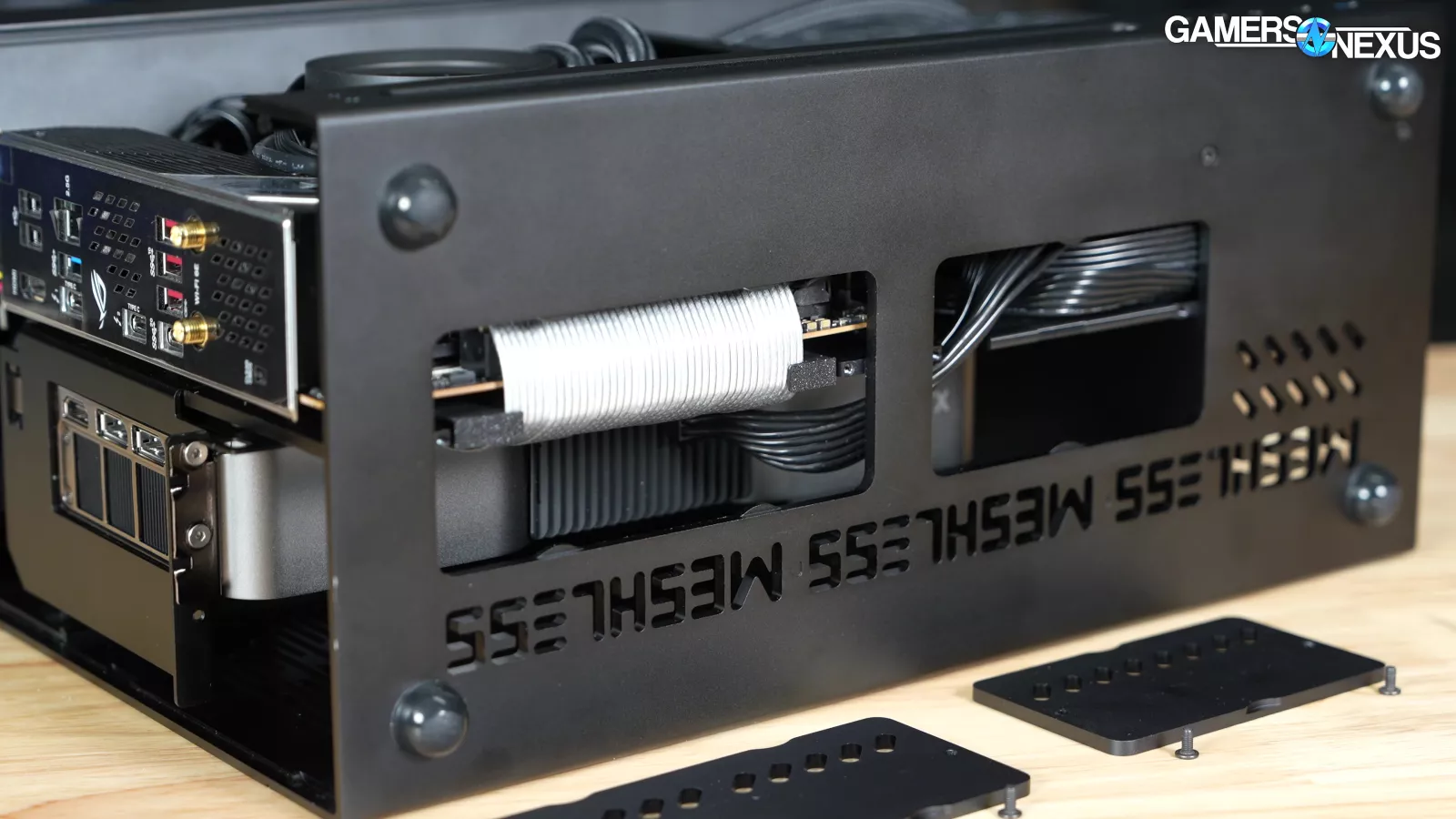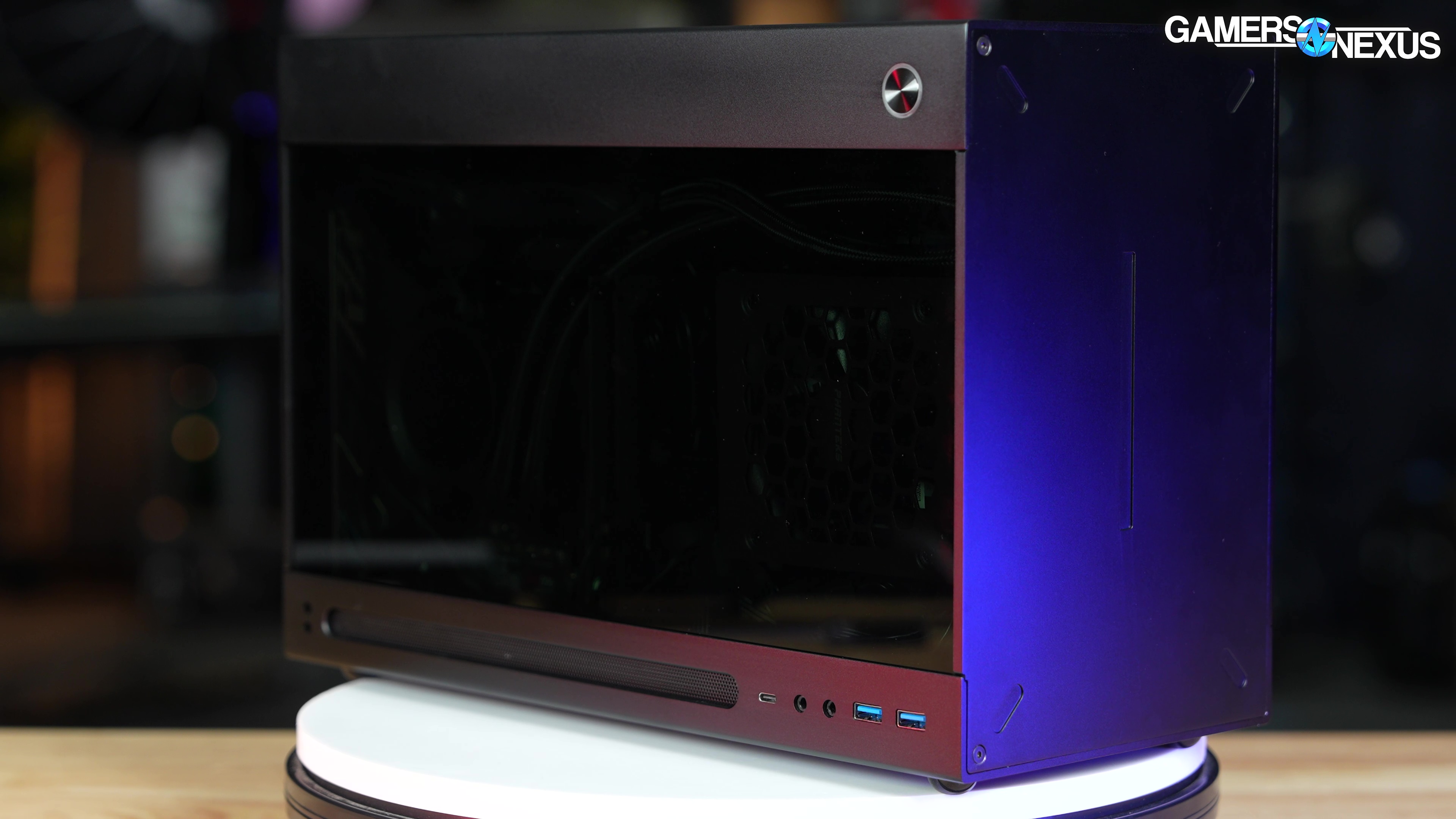
A Better Computer Fan - Sometimes: Cross-Flow Meshless AIO Case Benchmarks & Review
Last Updated:
We analyze the performance and design of an innovative ITX case that uses a single cross-flow fan
The Highlights
- The MESHLESS AIO eschews traditional axial fans in favor of a novel cross-flow one
- The PSU gets limited airflow and our fan controller PCB broke off its mount
- The MESHLESS AIO innovates and largely succeeds with its clever execution
- Original MSRP: $360
- Release Date: May 2024
Table of Contents
- AutoTOC

Intro
The small form factor MESHLESS AIO case works by using 0 axial fans and 1 cross-flow fan, which works by creating a lower velocity air movement perpendicular to a longitudinally rotating cylinder, with a tangential flow path. The theoretical end result is a laminar, evenly distributed flow. In this story, we did some practical demonstrations with Schlieren imaging on the case. We also did a full suite of acoustic tests in our hemi-anechoic chamber.
All of this was worth doing because this strange idea works. It’s not the most efficient way to cool a computer and it doesn’t allow for the best value, but its performance is worth studying in depth.
Editor's note: This was originally published on April 30, 2024 as a video. This content has been adapted to written format for this article and is unchanged from the original publication.
Credits
Testing, Host, Writing
Steve Burke
Testing, Writing
Jeremy Clayton
Camera, Video Editing
Vitalii Makhnovets
3D Animation
Andrew Coleman
Writing, Web Editing
Jimmy Thang
The case is innovative in other ways, too: It has a lever that moves the PCIe riser into place on the GPU to make it easier to install in the small space and it ships with a flow guide that easily mounts to the side panel of the chassis.
The MESHLESS AIO mini-ITX case is a fundamental rethinking of case airflow and doesn’t mimic or emulate any other case we’ve ever worked on before. The case has a solo designer who emailed us months ago, and we’ve spent all of that time thinking about and working on the testing. In this educational deep-dive to the MESHLESS, we’ll get an opportunity to learn even more about fans.
The MESHLESS AIO should be coming some time in May for $360, according to its solo designer. That’s very expensive – no getting around that. However, it’s produced in an expensive way – it’s mostly one giant 4mm thick aluminum extrusion that forms a unibody. Since it’s all one piece of metal, it doesn’t need screws or rivets to hold it together structurally. This makes the MESHLESS AIO extremely sturdy, with essentially zero flex. The unibody is finished with CNC machining to add all the necessary cutouts and mounting points.
Optional accessories include a flow enhancer and tiny RAM fan, both of which we’ll test.
Unorthodox Airflow
The MESHLESS AIO’s cross-flow fan sits above the GPU and below a CLC radiator by sliding in on integrated rails. The airflow pattern has air come in through the top radiator, the bottom three quarters of the right side panel where the GPU is, and through the mesh slot below the motherboard on the left side.
The air on the motherboard side is drawn through the holes above the motherboard and PSU. There’s also holes cut out on the bottom of the case on the GPU side, which are meant to be passive exhaust holes for large GPUs. With our modestly-sized RTX 4070 FE, they probably end up as more intake. All of this air converges at the fan and is exhausted out through the upper quarter of the right side panel. When the fan is running at full speed, there’s a solid wall of directed air blasting from the whole length of the fan.
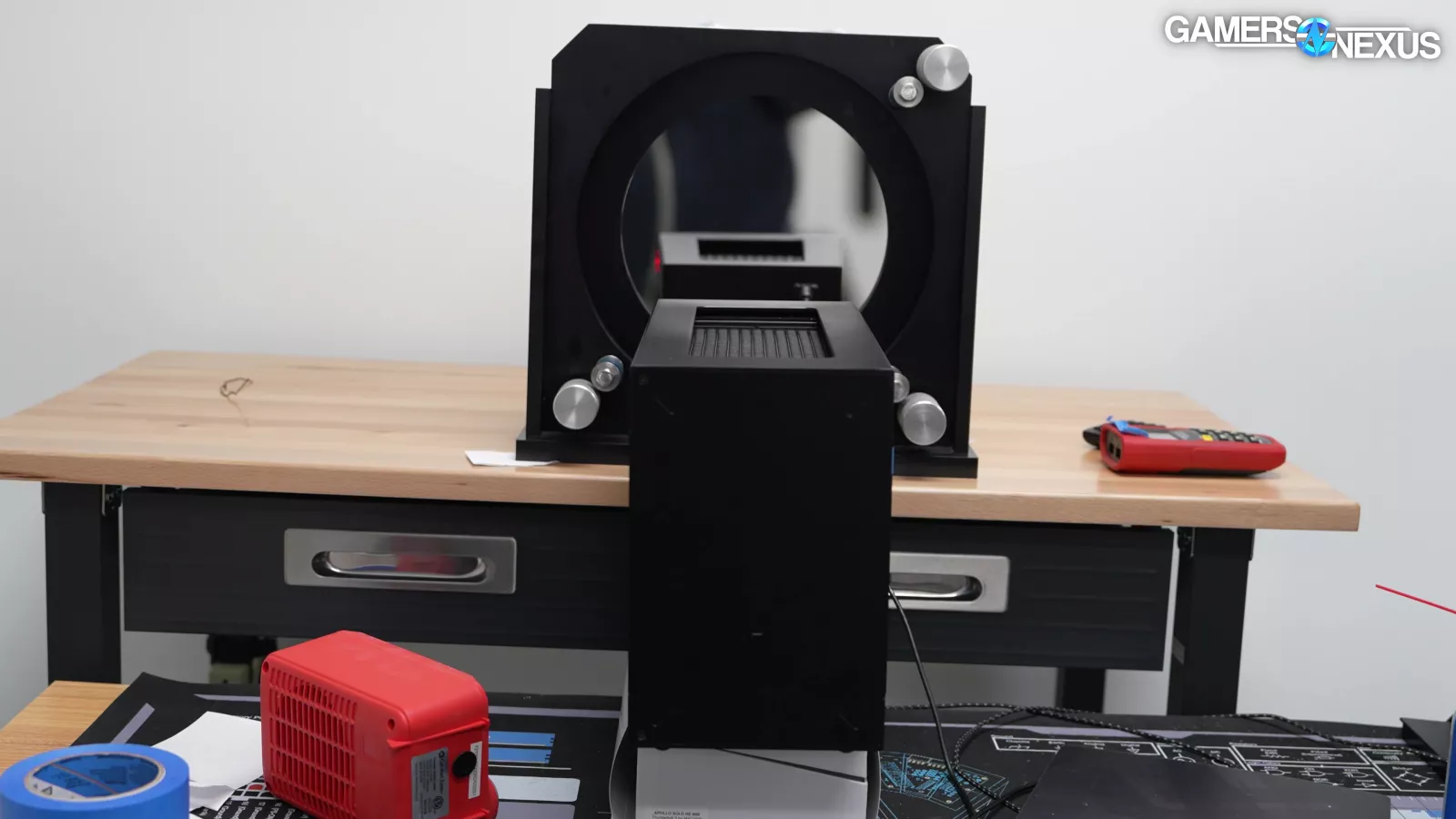
Make sure to watch this to see how we set up our Schlieren imaging.
And this is the Schlieren imaging we produced.
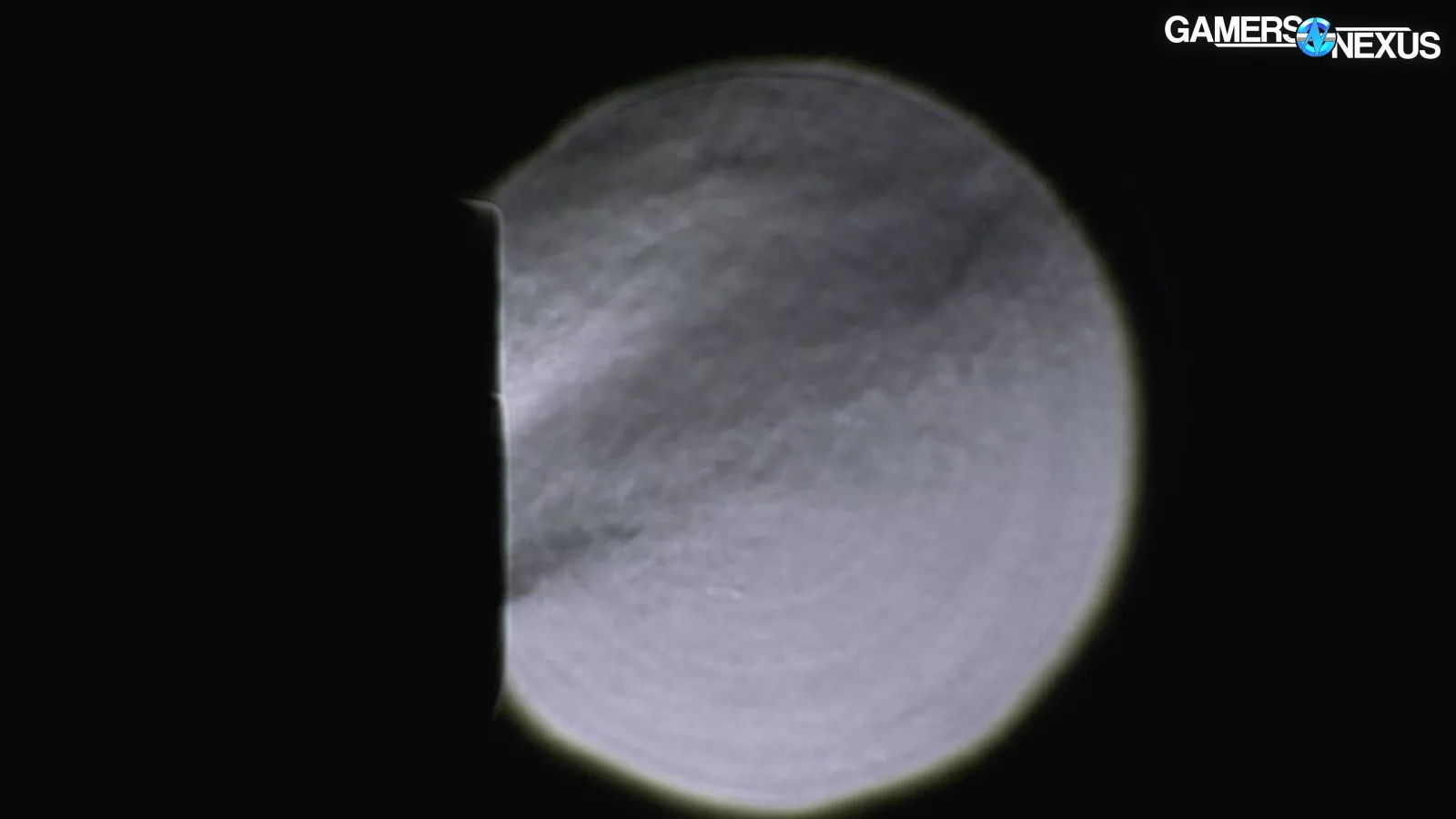
First, here’s the exhaust side of the cross-flow fan. You can see the air exits up at a 45-degree angle, which is great because it helps prevent re-circulation of hot air in through holes in the bottom or sides of the case. That’s excellent design to project it up and away rather than just straight out.
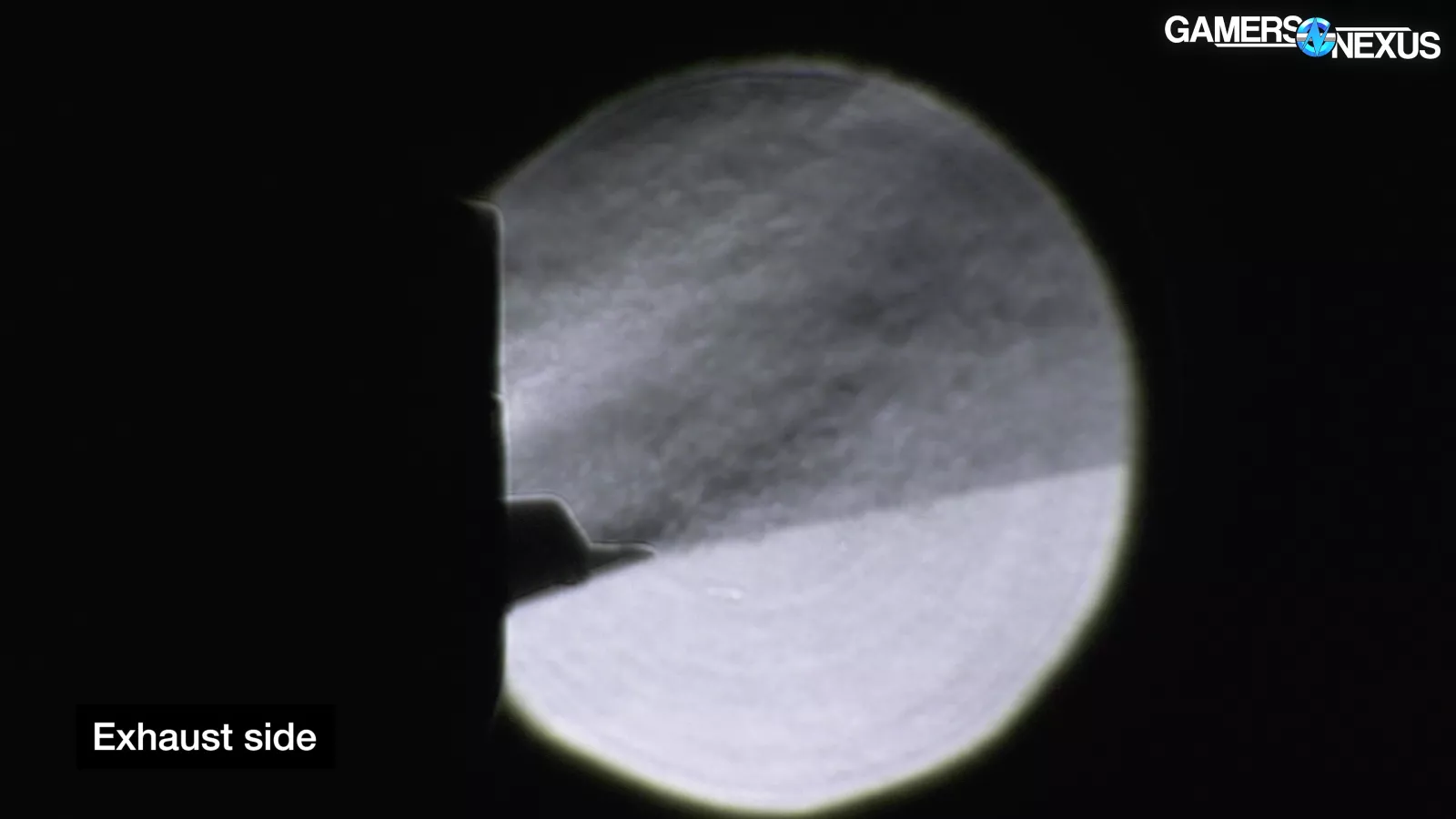
The flow enhancer is actually fascinating as well: With it on, you can see that the exhaust path doesn’t change much, but it does better angle the air away from the case. The other reason this works is because it is instead blocking the cooler air lower in the frame from being sucked up into the exhaust path and pulled away. This allows that air to instead find its way into the case through the lower two-thirds of the side panel.
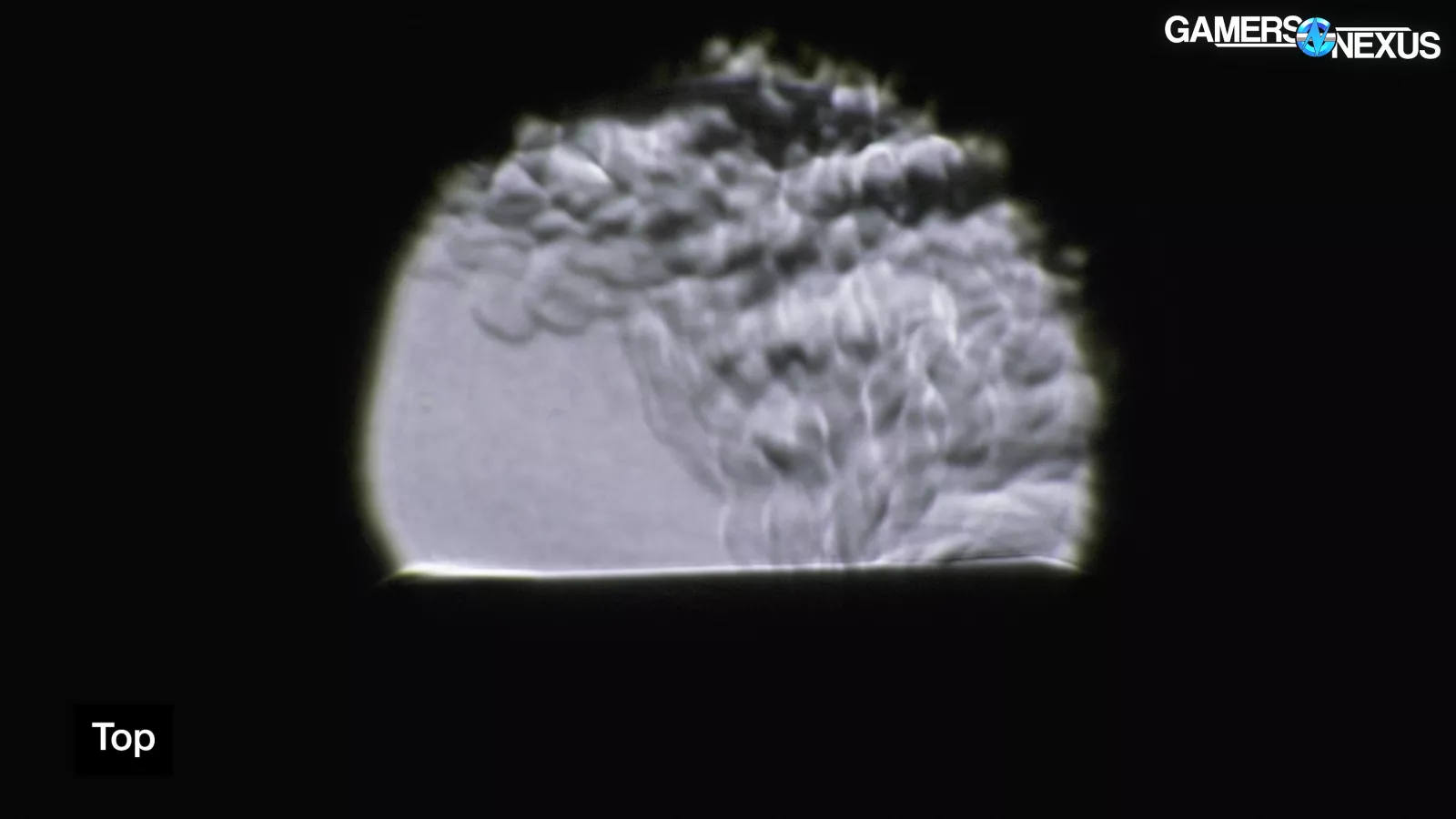
This orientation shows us air intake at the top of the case. When a hot object is held above the case without any air movement, the shifting air density is observable getting pulled into the top with a bias toward the right side of the case (or towards the fan’s mount and exhaust). The currents of the exhaust also help pull the air this direction.

Using an upside down air duster, you can see that even when we move the output towards the left, the air still pulls right. One side of the radiator gets a higher speed of flow here.
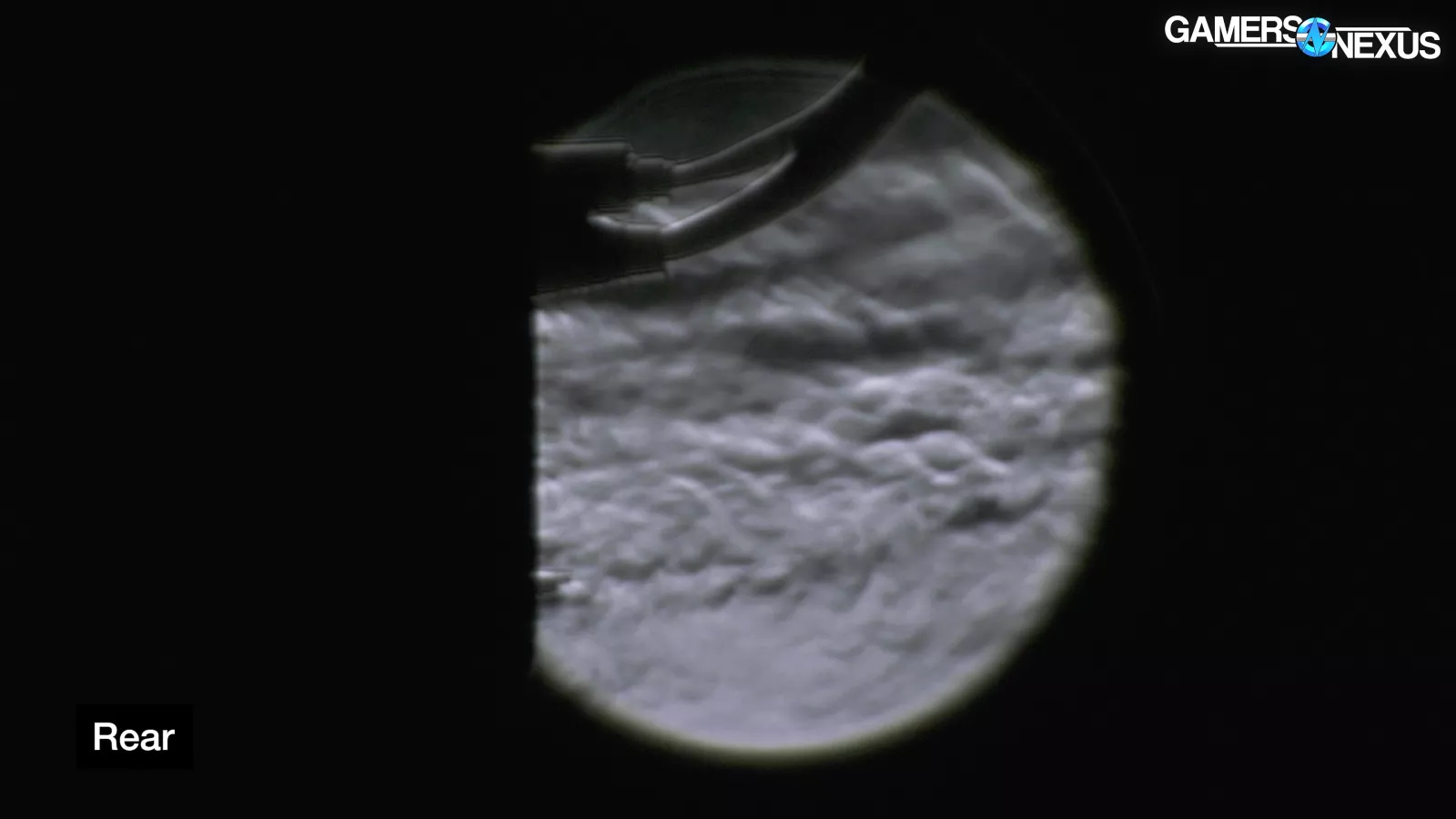
We were curious if the rear was acting as intake or exhaust. You can see that it’s exhaust: The air is flowing out of the case thanks to the video card’s fans. There is some very slight air intake at the bottom-left of the frame at slow speeds.
The MESHLESS is really serious about the concept of this fan and includes features like 3D printed parts to maintain a divide between the two sides at the cable pass through at the bottom.
There are some downsides to this approach: We don’t think the GPU has enough space behind the back of it, especially for modern flow-through designs found in most NVIDIA cards that will run into restrictions. More on that down below in the testing.
Cross-Flow Fans
We wanted to take this opportunity to both learn and teach about how this kind of fan works. This style of fan is again called cross–flow, transverse, or tangential, and in the world of fans, they’re a relative newcomer at 131 years old since the first patent. The only case we could find that used one was the 20 year old Cooler Master CM Stacker as an optional part. SilverStone also made one for general small form factor applications.
A cross-flow fan is divided into blocks that are separated by joint discs, constructed of cross-sectional curved blades in a circular pattern. In this configuration, a drum rotor sits on one end to provide power. There are also duplex cross-flow fans where two fans adjoin a central impeller, but that’s a different use case.
We’ve been making some big behind-the-scenes moves lately to start introducing educational animations anywhere possible. You can check that out here.

A traditional and simple axial fan slices through the air to scoop and move it in the targeted direction. Choices in blade shape and design can dictate how wide or straight that column of air is, but the concept is the same.

Squirrel cage blower fans, or centrifugal fans, pull air into the center and then eject it outward along the blade path. This is useful in cramped areas to evict air quickly, like in handheld gaming devices or laptops where you need to exhaust the hot air out of the chassis as fast as possible.
For a cross-flow or transverse fan, the fan is a longer and narrower cylinder that rotates longitudinally, with air entering perpendicularly to the rotational axis and being evicted from the cylinder tangentially to that axis. Unlike the blower fans we normally see in laptops and some GPUs, a cross-flow fan doesn’t pull air in from the middle of the impeller. Instead, it has separate inlet and outlet sides across the entire length. The outlet is formed by this wedge or “vortex wall” stabilizing the air vortexes in just the right way to create directional flow through the impeller. These fans are used in situations where a constant laminar stream of air is desirable without the buffeting effect of large axial fans.
The total pressure of the fan is proportional to the square of its speed, according to research by Yong-Cheng Shih, et al, and research in 1973 by Eck, et al. found that a reduction in the angle of attack improves the total pressure coefficient. Later research discovered a combination of tuning to the angle or curve of the blades across the length of the fan would further improve pressure. You can see this present in the modern cross-flow fan used for the MESHLESS PC case -- its angle gradually swoops from right to left.
Cross-flow fans create lower velocity air movement from in-to-out and produce a laminar flow which gets evenly distributed across the length of the blade. You might find these in a common standing room tower fan, where the goal is to distribute air widely across the room, but not to direct it to any particular pin point. Cross-flow fans can also be found in certain HVAC products, refrigeration products, and outside digital signage and billboards. They’ve also been considered for aviation use inside the wings of planes, but the idea never really got off the ground.
A cross-flow fan has that downside: It isn’t going to force as much air as fast into a single inlet cooling a single device, but it will more evenly force air into the chassis.
Let’s get into the thermal testing. For this, variables we’re considering include: the fan speed, which can be adjusted to 100%, 65%, or 45% with a switch; the optional flow guide; and the fan being replaced with our hacked-together axial solution just for comparison.
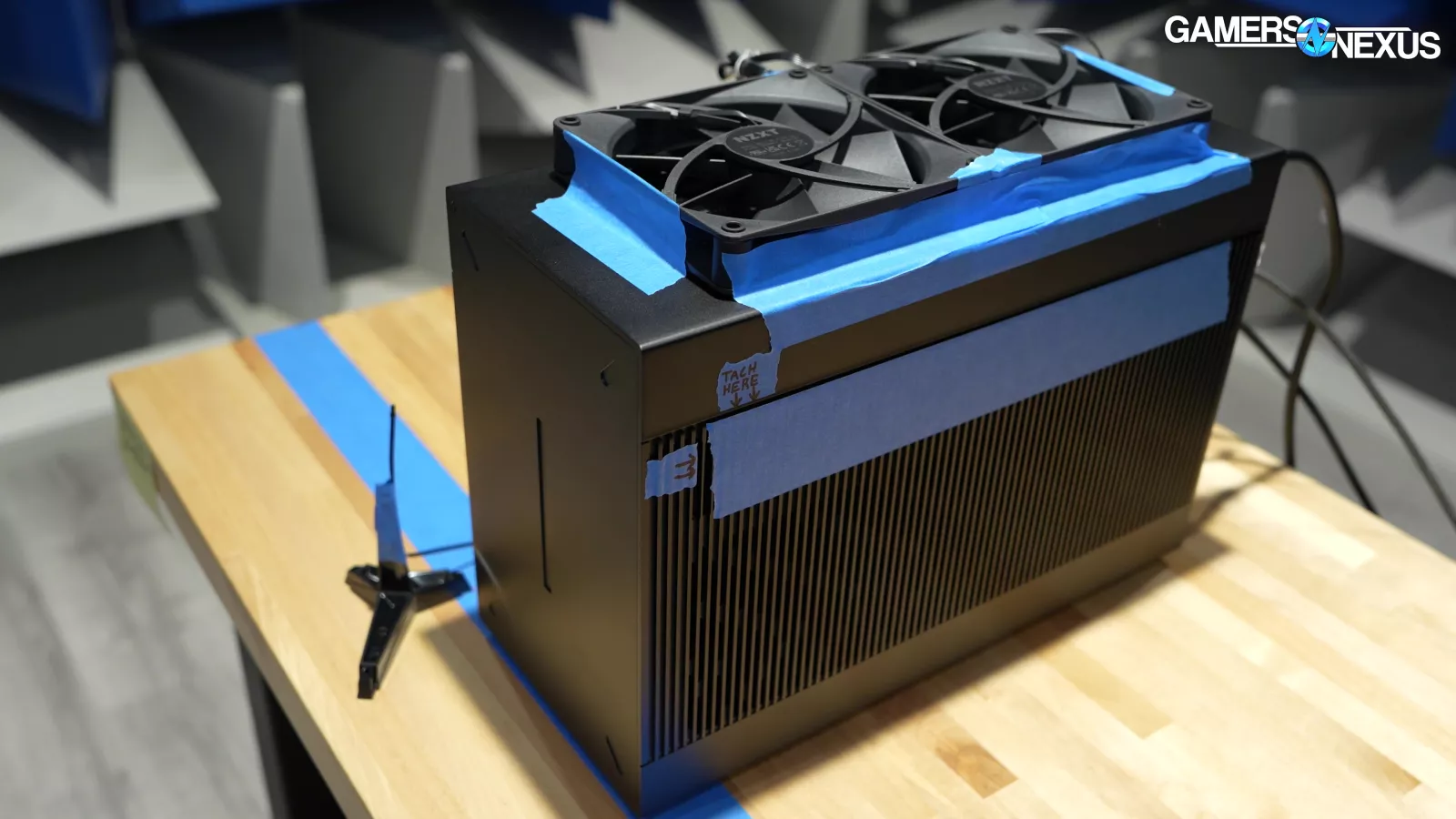
Testing is done with a Kraken 280 cooler without its fans unless otherwise stated.

GN Mini-ITX Variable Test Bench (2024)
| Part | Standard Component(s) | Provided By |
| CPU | Intel i5-13600K @ Fixed clocks & voltages (clocks/voltages determined per case; we may settle on permanent settings once we get past our first few ITX case reviews) | Bought by GN |
| GPU | NVIDIA RTX 4070 FE | NVIDIA (review unit) |
| Motherboard | ASUS ROG Strix Z790-I Gaming WiFi | Bought by GN |
| PSU | Corsair SF1000L 1000W SFX-L Phanteks Revolt SFX 850W | Bought by GN Provided by Phanteks |
| RAM | GSkill Ripjaws S5 2 x 16GB | Bought by GN |
| SSD | Samsung 960 Pro M.2 NVMe SSD | Bought by GN |
| Coolers | VARIABLE Standardized options: 240mm CLC: Fractal Design Lumen S24 v2 RGB 120mm CLC: Arctic Liquid Freezer II 120 "Standard" Tower: Scythe FUMA 3 or Deepcool AK400 Short Single Tower: Noctua NH-U9S Mini-Tower: Noctua NH-D9L Downdraft Low-Profile: Deepcool AN600 67mm Alt. Downdraft: Noctua NH-C14S | Fractal Design, Arctic, Deepcool |
| Additional Fans (Optional) | VARIABLE Standardized options: Arctic P14 Slim PWM PST 140mm Arctic P12 Slim PWM PST 120mm Arctic P8 Max 80mm Noctua NF-A6x25 PWM 60mm Noctua NF-A9x14 PWM 92mm | Arctic Noctua |
MESHLESS AIO Thermals
MESHLESS AIO CPU Thermals - Full Torture
Time for torture testing with a full CPU and GPU workload.
At 100% fan speed and stock, the cross-flow fan kept the CPU P-cores at 35 degrees Celsius over ambient, with the all-core average 3 degrees lower. This had it running at 37.8 dBA at 1m in our hemi-anechoic chamber. Conveniently, this is almost the same noise level as when we taped the two axial fans to it instead, which ran 5 degrees warmer. That’s great news for the cross-flow fan, but a word of warning:
Because this case wasn’t designed for axial, the fans are blocked around the edges when held in place. It’s not a fair comparison, but we still wanted to run it out of curiosity.

In other words: a cross-flow fan won’t always be better. This entire case was designed ground-up for this solution, so axial fans will remain superior in most computer use cases, but when carefully designed for cross-flow, our data suggests it is possible to produce a better result.
The flow enhancer did improve performance from stock, dropping about 1 degree from the baseline result. It’s not just a gimmick. Adding the RAM fan didn’t change the CPU results outside of variance, but we’ll look at the RAM temperatures in a moment.

Adding the seat belt boosted the temperature as it ends up blocking large parts of the radiator due to its floppy nature: The temperature increased over 1 degree from baseline.
Dropping fan speed to 65% reduced the noise by almost 10 dBA, or a perceived effective doubling in noise when going from 65% to 100%. The temperature increase was only 3-4 degrees. Finally, the 45% result is close to “silent” at 25.3 dBA in our hemi-anechoic chamber with a noise floor of 13.6 dBA.
MESHLESS AIO GPU Thermals - Full Torture
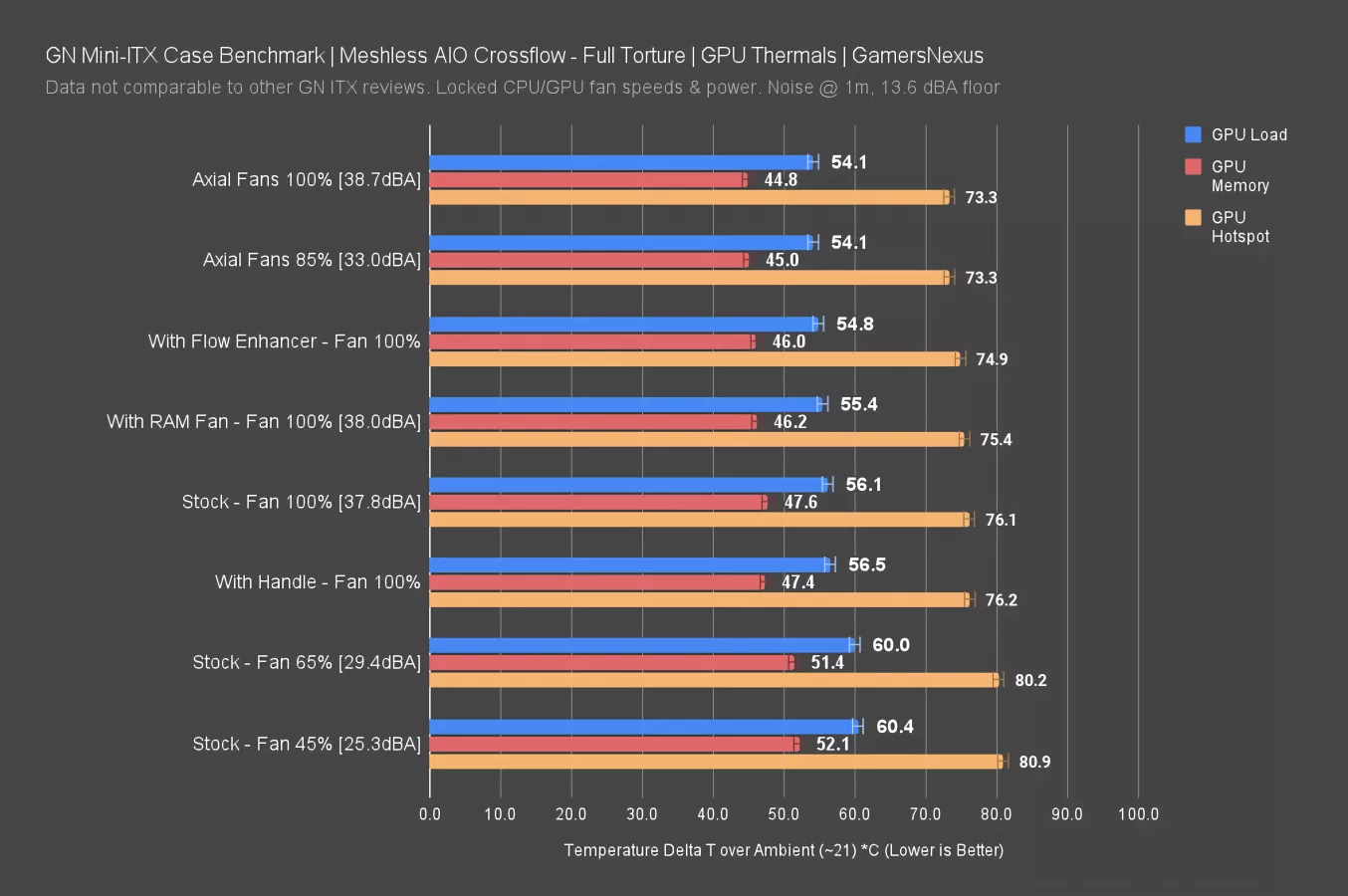
GPU thermals aren’t as good, so this is the weak spot, especially with a flow-through cooler. The axial fans were actually the best here, despite being mostly blocked. The GPU ended up at 54 degrees for average load temperature with both speed variations of the axial fans, although GPU memory temperature was slightly better on the 100% test but within variance. This isn’t abnormal to see: The GPU isn’t in the direct flow path of the fans, but it is far enough from the cross-flow fan path that it performs better axially. This mostly has to do with the pressure system that's forming within the case.
The first cross-flow appearance is the flow enhancer, which has the GPU at 55 degrees load. That’s improved from 56 without the enhancer. The handle hurts performance again, with fan speed reductions obviously impacting it the most. The bottom two results see a hit to frequency, where the 45% result drops 20MHz from the clocks.
This is a less favorable set of results compared to what we saw on the CPU, and we suspect that the design of the case doesn’t do the 4070 FE design any favors. There’s barely any room behind the flow-through portion of the cooler, and any air that’s ejected towards the bottom of the case has a strong likelihood of being recirculated.
This could be improved on in a couple of ways. Number one would be coming up with some way to mount the GPU closer to the outer wall no matter how thick it is. Number two would be using a GPU with a more traditional cooler design where hot air is blown out the top and bottom edges of the cooler if you get one with a vertical fin stack, which would maybe allow the case’s fan to pull it out directly.
MESHLESS AIO VRM & RAM Temperature

This last chart looks at RAM and VRM thermals.
The tiny RAM fan definitely does something: SPD Hub temperatures on the memory dropped to 14 degrees over ambient when using it with the cross-flow fan with the memory fan, which is an impressive reduction of 5-6 degrees against the most relevant results. The RAM fan had a small benefit for VRM MOSFET thermals as well.
The axial fans otherwise did the best and were within error of each other. Using the cross-flow fan with the flow enhancer was 1 degree better than without the flow enhancer, but not as good as with the RAM fan.
Clever GPU Mechanism
Let’s get back to the case and talk features and fitment.
For features, the GPU installation is clever:
Since the GPU area of the case is closed off on all sides, the GPU is inserted from the back of the case.
This bracket goes onto the GPU, then the slots on the side of the bracket slide into place using screws under the motherboard as guides.

It works well.
In order to attach the PCIe riser to the GPU, the MESHLESS AIO has a lever operated mechanism that lowers the riser slot down onto the connector on the card. Plastic 3D printed guides ensure that it lines up during the process. It can be a little stiff to move into place, but it’s a brilliant solution given the inherent space restrictions.
MESHLESS AIO Fitment and Dimensions
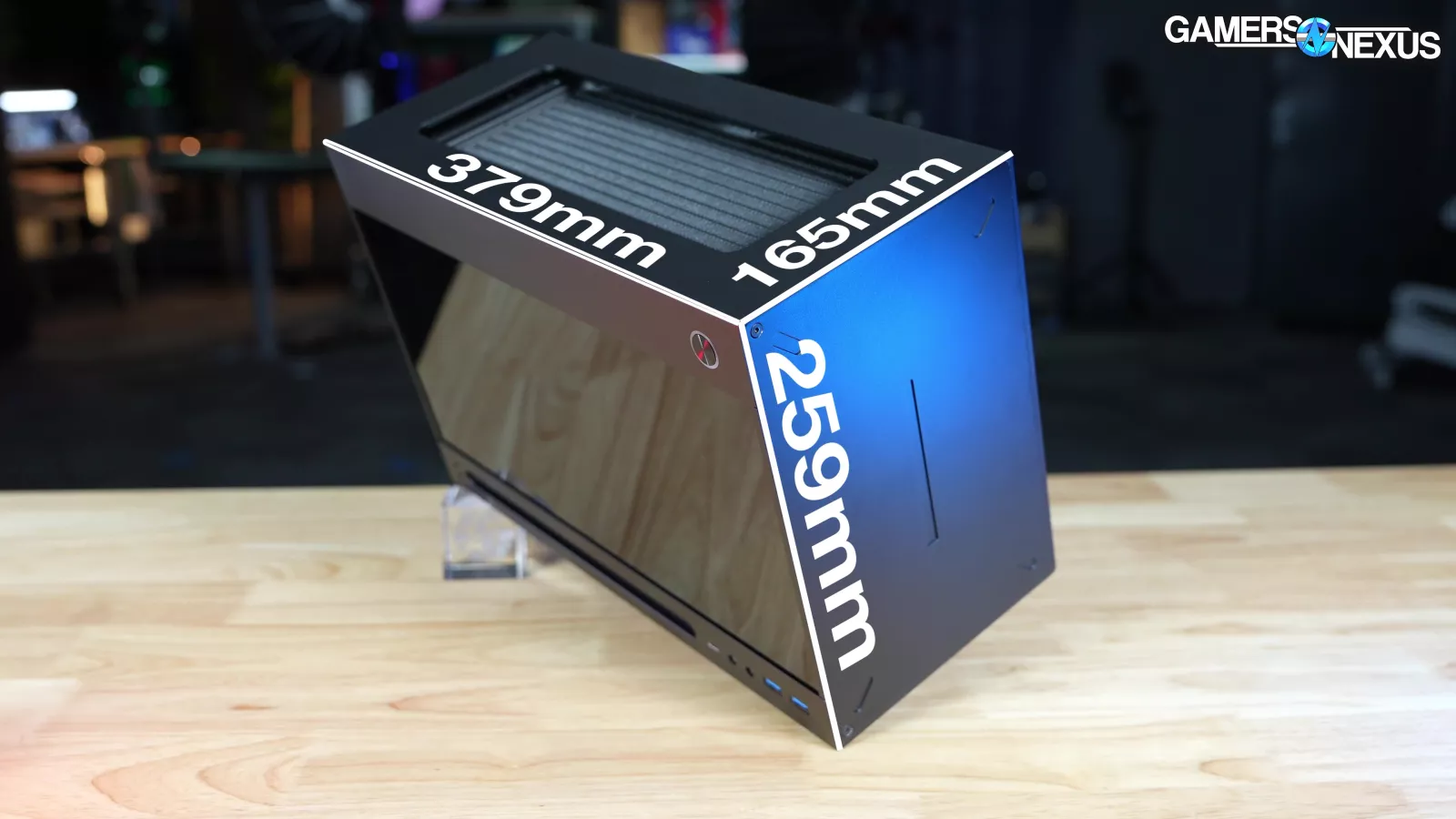
The case measures 379x165x259mm, which is 9mm longer and 10mm taller than on the spec sheet. The rear PCIe bracket and case feet make up the differences. That makes the outer volume 16.2L – well within SFF territory but not incredibly small.
GPUs up to 362x78x163mm are supported, which includes the massive Aorus Master 40 series cards. Those are the largest we’re aware of, so everything currently on the market should technically fit – obviously, do your own research to confirm and look for protrusions.
As usual though, fitting doesn’t mean it should go in the case. The larger the GPU, the more it will struggle with constrained space and potentially drop clocks.
CPU cooling is designed entirely around 280mm CLCs, and the bracket doesn’t even have mounting holes for 240mm radiators. The radiator itself can only be up to 30mm thick, which rules out Arctic Liquid Freezers, and the block can only be up to 56mm tall, which blocks a few options. We used the NZXT Kraken 280, so we know that fits – but getting rid of the fans means some dead ends on modern CLCs with rats’ nests of cables on the block.
For power supplies, both SFX and SFX-L are supported, with the usual reduced cable management space when using SFX–L.
MESHLESS AIO Design Positives
We like the execution. The MESHLESS AIO gives you a guided build experience with just one final configuration in mind, and does it well. And it’s unique.
The MESHLESS is more like the Lian Li Dan A4-H2O in terms of maximizing one build style. If you boil it down to base elements, we think the A4-H2O is the MESHLESS AIO’s closest competitor. The layout is very similar, but the H2O is half the cost and is manufactured completely differently. It also uses standard axial fans.
We like the use of integrated rails: Internal components like the cross-flow fan, radiator, and optional handle mount cleanly install with these. The side panels hinge into place with small tabs and secure with screws, and unlike the NCASE, it’s way fewer screws. All these things work well.
The 2.5” drive mount can hold two drives at an angle between the motherboard and PSU and is secured with a single screw. Above that, there’s a hook to help keep the CLC’s tubes in place.
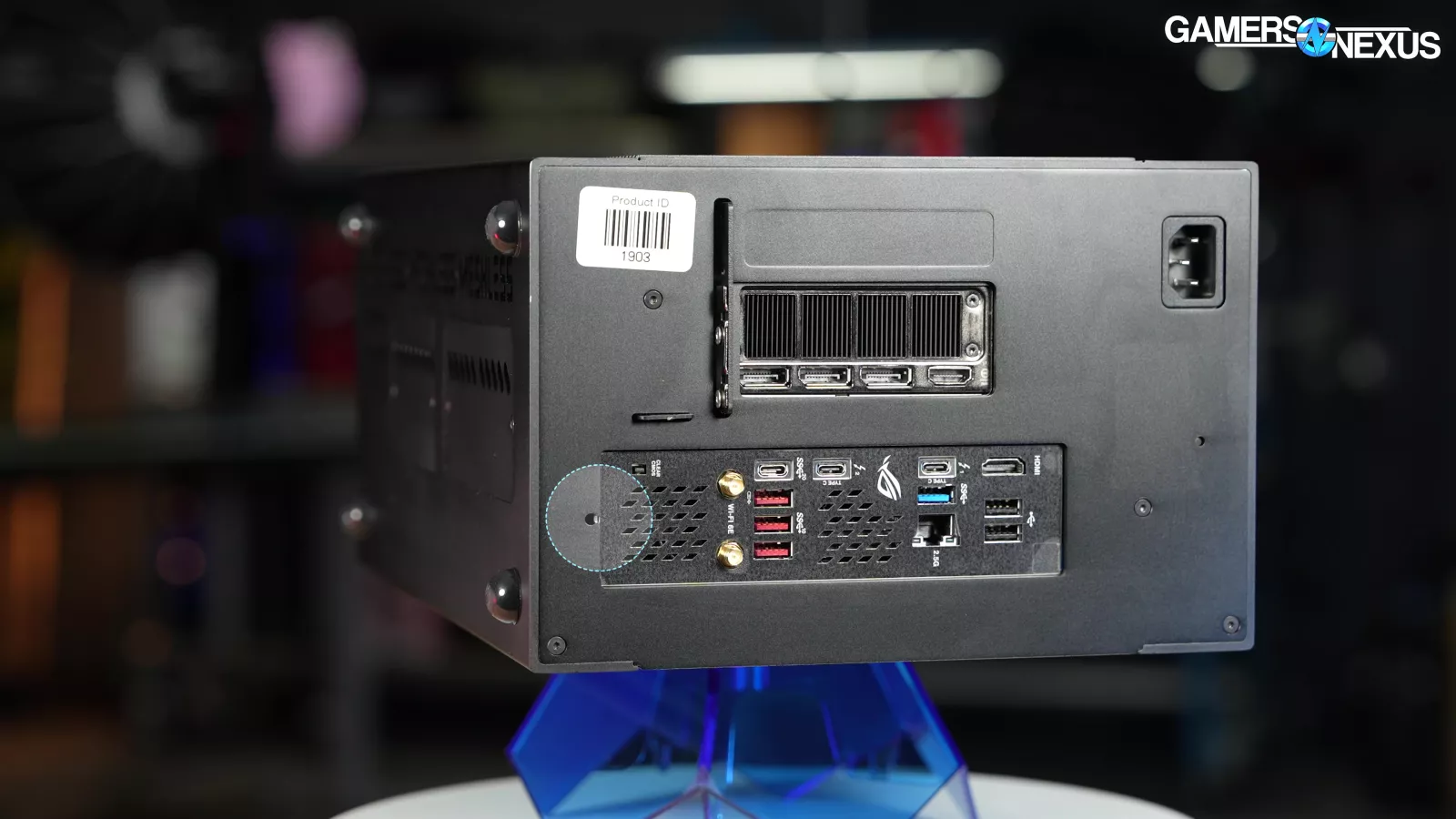
There’s also a small hole in the rear panel below the motherboard I/O so you can run a wireless antenna back inside the case – we used it for a thermocouple wire. That’s a lot of thoughtful touches.

As a last positive note, the manual is well done and helpful, even in its current unfinished state. The cable routing suggestions are particularly helpful.
MESHLESS AIO Negatives
Now for some negatives.
For starters, the fan controller board on our sample broke loose from its mounting. This could be a one-off issue, but the method of soldering standoffs to the face of the PCB wasn’t sufficient for the one we have. We fixed it with screws.
The PSU mount was another problem. It seems like the bracket’s design takes the exact placement and size of the AC plug and power switch for granted, as neither of our standard test PSUs fit perfectly. The end result is that we had to force it to fit, and the PSU doesn’t sit correctly in the machined area. This could be fixed if MESHLESS tweaked the bracket’s design.
We’re also concerned about the PSU being starved of fresh air, considering that the vent doesn’t extend to underneath the PSU, and it’s surrounded by close glass and aluminum.
We also found it difficult to plug GPU power into our standard height card. Larger bottom cutouts would make this easier, as would a taller GPU or longer cable.
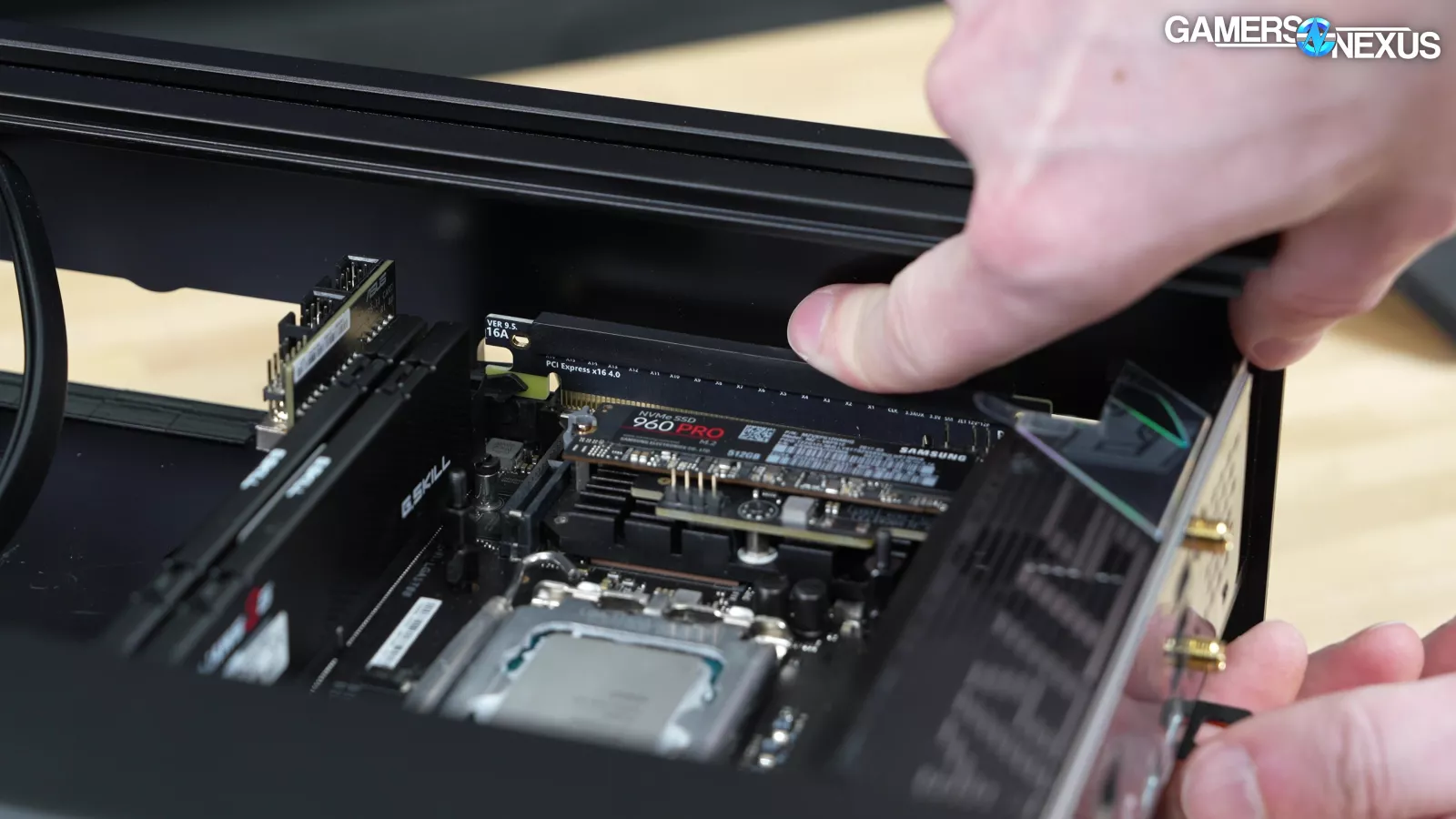
Also, access to the bottom edge of the motherboard isn’t easy. It’s tolerable, but that’s about it.
MESHLESS AIO Conclusion

Whenever a solo designer contacts us about a product they've been working on, we carefully evaluate the situation. In this case, the MESHLESS AIO is a serious product with a really unique approach to airflow in a computer chassis. Cross-flow fans have been around for a little over 130 years. They have technically been used in computers but it requires that ground-up effort to shape the entire product around using it so it's not as simple as just throwing a cross-flow fan into a case and thinking that you’ll get a compact, reasonable performer.
Trying something weird and different like what MESHLESS did with this case is important because if no one ever tries something weird and different, we might never find out that there may be a better way to do things. Often, we find that there are better ways to do things and the crazy thing is that still happens in thermals and cooling, which seems like elements that should be mostly figured out but aren’t. In this case, the cross-flow setup actually works well overall.
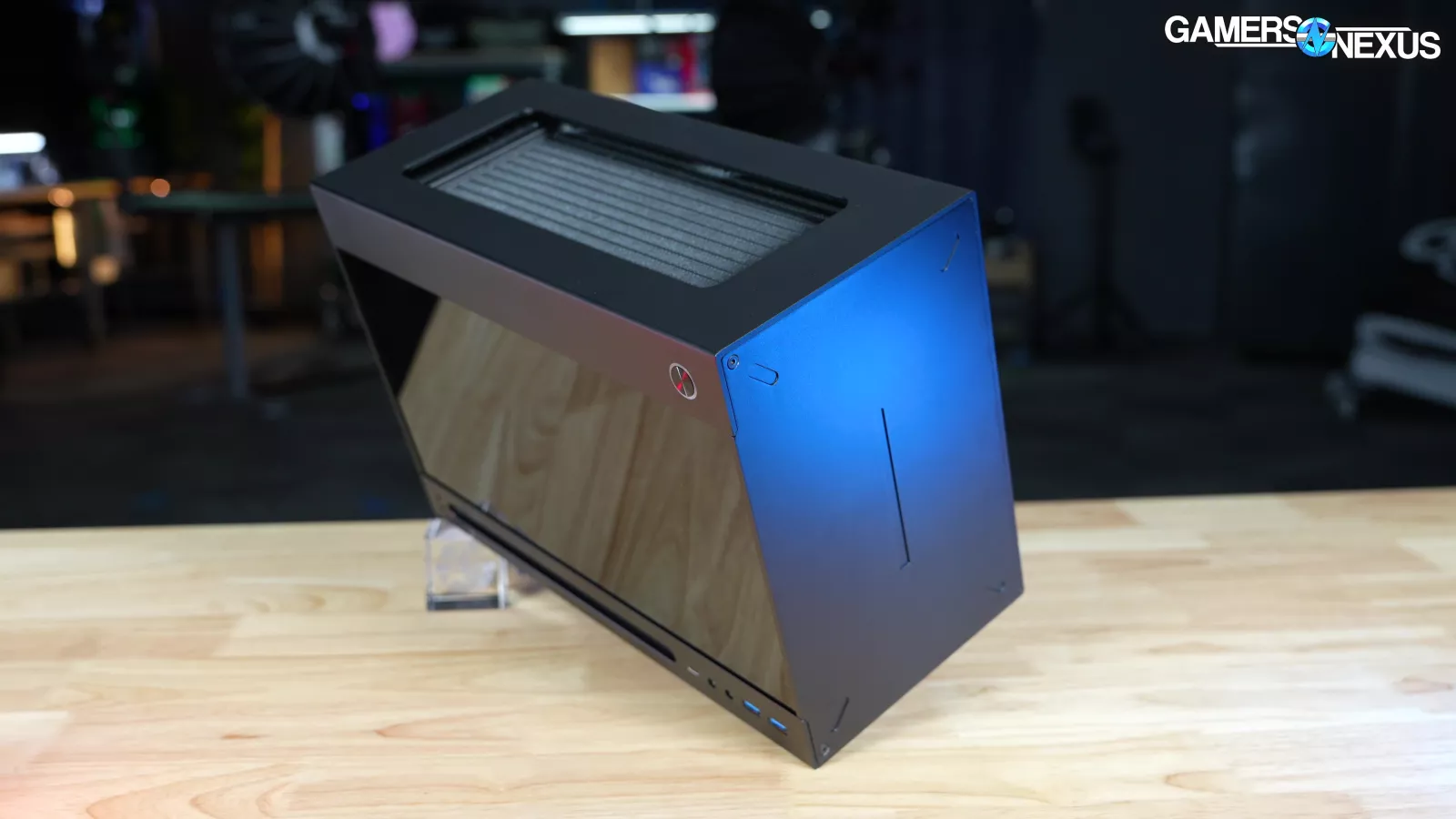
This isn't a definitive answer to all small form factor cases but we think it's a really good execution and we're surprised at how well it works to where there's not really a problem of building it, at least with the parts we used.
To summarize some general positives and negatives, there’s real innovation in case airflow. It's a smart execution. It uses an unorthodox solution, but it's very expensive at $360. It is, however, an expensive manufacturing process. We think Lian Li’s A4-H2O is the closest competition to the MESHLESS AIO. It costs about 155 bucks and is very similar aside from the fans but if you want something that looks similar externally and is more traditional, this is where we would point you. Make sure to check our review of that case.
The design of the MESHLESS AIO is very focused with lots of clever and thoughtful features. We wouldn't be surprised if its GPU mount finds its way into competing products eventually. The CPU thermals were very good. The GPU thermals are passable. We think dedicated flow-through card designs like NVIDIA’s Founder’s Edition aren't the best choice for the case, unfortunately.
Recapping areas for improvements, the bottom cut-outs should be larger for ease of use. The power supply mounting bracket doesn't work properly with some PSUs. We're also concerned about the power supply's access to air and the fan controller PCB broke off its mount.
Those elements aside, it's a really clever execution and we enjoyed working on the case. It’s super cool and innovative. It’s not prohibitively expensive if you look at the ITX market but it’s definitely expensive. If you want cheaper options, there's a lot of them out there but it's not like it's some insane $600 solo artist project.
